

Next-Level Reliability
By Andy Carter Member Engagement Manager
The wholesale electricity market constantly evolves to keep up with technological changes and growth coming from beneficial electrification. Empire Electric Association’s wholesale power supplier, Tri-State Generation and Transmission Association, works to maintain its competitive edge in the marketplace with affordable power prices and its commitment to reliably deliver power across four Western states to over 1 million people.
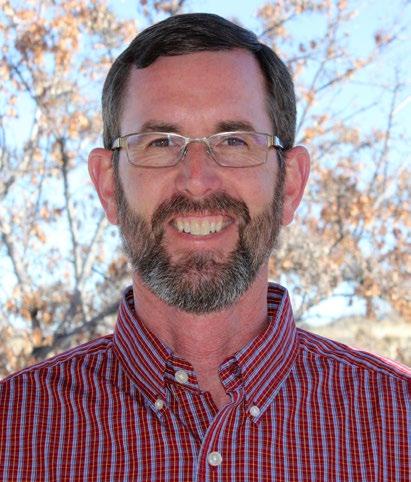
Studying the changing generation landscape and analyzing recent extreme weather has helped Tri-State understand that using traditional planning methods alone will not allow it to fully demonstrate its reliability commitment to its members. The increase in intermittent power resources, and the continued importance of dispatchable power plants that can provide power on command, has driven Tri-State to develop what it has defined as “Level 2 Reliability Metrics.”
Traditional energy resource planning has focused on demonstrating enough reserve generation capacity to ensure outages would occur only one day in 10 years. The idea is to plan for enough generation to meet peak load plus reserve capacity that accounts for generation outages or extraordinary events, such as extreme winter storms.
This is an effective planning process when most generation assets are dispatchable or can generate power on command if they have fuel and are operational. An example of a dispatchable generator is a natural gas power plant. Unless something at the plant breaks or it runs out of gas, it can generate power when needed.
Solar is an example of an intermittent, nondispatchable power resource. Sunlight, which makes
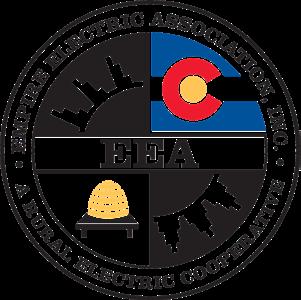
solar power generation possible, is not available on demand. Sun exposure potential is very predictable, but the uncertainty of cloud cover makes it difficult to predict actual power output even during daylight hours. The increased complexity of resource planning by the growing percentage of nondispatchable resources and increasingly frequent extreme weather conditions has caused Tri-State to reconsider its reliability metrics.
Tri-State continues to plan for the industry standard of one day in 10 years loss of load expectation while maintaining its self-defined Level 2 reliability metrics. Level 2 reliability demonstrates that Tri-State can meet its member cooperatives’ needs even during extreme weather events. To determine the resources required, Tri-State performs computer simulations using different generation resource mixes subjected to extreme weather events to see if it still has enough power for its members without requiring power purchases from the open market.
Level 2 reliability is just one reason EEA continues to prefer Tri-State as its power supplier. Tri-State is on track to achieve regulatory clean energy requirements on time, all while keeping rates affordable. EEA’s new wholesale energy supply contract provides EEA membership with the opportunity to increase self-supply from 5% to 20%, with an additional 40% available through Tri-State’s innovative Bring Your Own Resource program.
The best part is that all of this comes from a fellow cooperative that shares our values and focuses on us and not on profits. Being a Tri-State member is truly a next-level experience.
833-923-1409
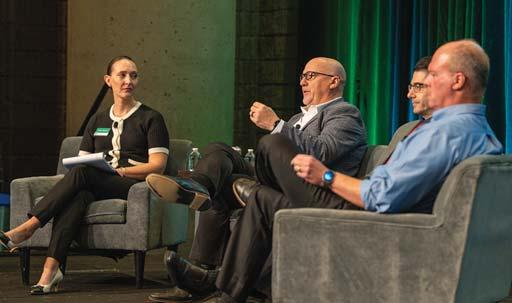
Fiber Make-Ready
The process of ensuring that power poles can safely accommodate communications infrastructure, called “make ready” work, can be among the most time-consuming tasks of a fiber broadband buildout. Depending on their condition and configuration, existing poles may need to be replaced. The process involves surveys, inspection of every pole, engineering, construction and more. In the rural areas served by electric cooperatives, the low population density and difficult terrain can add to the cost and challenges.*
1.Inspection and Engineering
• Field surveys
• Pole assessment:
“Good condition” — Physically sound; enough wire clearance to accommodate communications lines “Poor condition” —Inadequate structural integrity or insufficient clearance; need to be replaced to add new attachments
"Red-tagged” — Physically compromised; need to be replaced regardless of whether new attachments are needed
• Loading and clearance analysis
• Design plans
• Cost estimates
2.Replace/ Reconfigure Poles:
• “Poor” or “red-tagged” poles replaced
• Move existing wires if necessary
Broadband space
3.Coordinate and Communicate:
• Work with local governments and other stakeholders on installation
• Secure permits
• Ensure compliance with the National Electrical Safety Code and applicable local, state, federal or tribal regulations
4.Safety and Prep:
• Clear obstacles and vegetation
• Ensure compliance with safety and clearance standards
*The depiction and text are intended as informative examples only and may not be exhaustive of all make-ready work considerations. Each system is responsible for performing due diligence with regard to make-ready work in light of its unique circumstances and applicable laws, rules or regulations.




5.Install and Test Line:
• Test broadband service n s :
• Install fiber optic cables and hardware i


Vegetation clearance
2025 EEA Annual Meeting Recap
Empire Electric Association held its annual membership meeting on June 19 to provide members with an update on EEA happenings and to complete the election for directors of Districts 1 and 2. The first speaker was Board President David Sitton who gave an update on the new member services building and several grants EEA is pursuing for fire mitigation efforts. The grants include converting overhead lines to underground, using drones and satellite mapping for targeted tree trimming, and upgrading protective devices that have enhanced capability to detect downed power lines.
Sitton also acknowledged the many years of dedicated service provided by retiring District 1 board member Jerry Fetterman. Fetterman was an EEA director for 20 years and served as secretary/treasurer as well as EEA’s representative to power supplier Tri-State Generation and Transmission Association.
Finance Manager Ginny Johnson presented EEA’s financial policy metrics that demonstrate EEA operates on strong financial ground. Johnson also covered the highlights of the 2024 financial report, reminding members EEA generated $1.18 million in operating revenue and paid members $1.68 million in capital credit retirements.
General Manager Josh Dellinger continued reviewing the year and emphasized that the cooperative’s success is due in part to the focus on performing ordinary tasks with excellence. He explained operational excellence not only calls for above and beyond responses to outages and extraordinary events that arise, but excellence also demands that ordinary tasks like driving to the job site, processing payments, or answering phone calls from members be done with the same effort and focus.
Dellinger summarized a few of the co-op’s accomplishments, including renegotiating franchise agreements with the City of Cortez and the towns of Dolores and Mancos, entering into a flexible supply agreement with Tri-State that allows EEA to purchase renewable power from San Miguel Power Association’s Naturita Solar project, and leveraging combined cooperative buying power to reduce material costs.
The first guest speaker at the annual meeting was Tri-State’s Chief Energy Innovations Officer Reg Rudolph. Rudolph provided insight into challenges
Tri-State faces as it seeks to provide reliable and affordable power to more than 1 million homes and businesses across four Western states. The geographic and load diversity of Tri-State’s 40 member cooperatives provides it with advantages in the market to remain price competitive while keeping its promise to provide reliable power. Rudolph also outlined the increased flexibility provided by the new wholesale contract signed by a majority of Tri-State’s members.
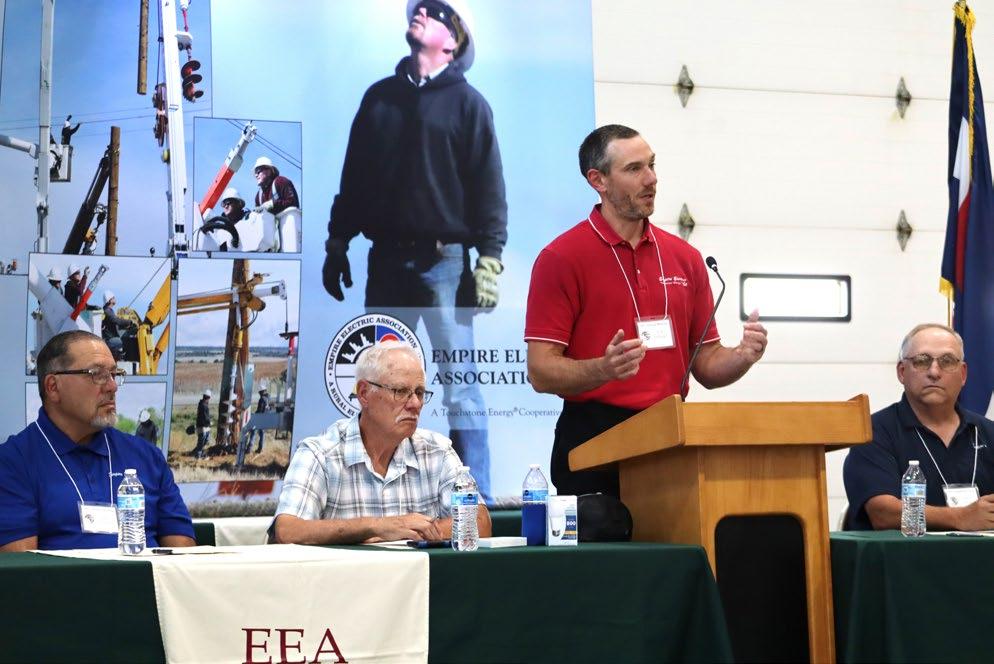
Colorado Rural Electric Association Executive Director Kent Singer also spoke at the meeting. He reviewed the legislative successes made possible by combining the voices of 21 rural electric distribution cooperatives into a single lobbying effort coordinated by CREA, the statewide trade association serving Colorado’s electric cooperatives. Legislative wins include securing consumer protections for residential solar sales and recognizing nuclear energy as clean energy. Singer also mentioned the Washington D.C. Youth Tour coordinated by CREA. This all-expenses-paid trip gives youth from rural cooperatives an introduction to the cooperative business model as well as the state and federal legislative processes.
Following Singer was the announcement of election results. Doug Sparks was elected to represent District 1 and Bob Barry was re-elected to District 2. Door prizes were given away at the conclusion of the meeting. We appreciate your support and look forward to serving you for many years to come.
EEA General Manager Josh Dellinger addresses members regarding EEA successes at the 2025 annual meeting. Photo by D. Moore
Better Secure Your Personal Information
In response to the growing threat of phishing attacks targeting utilities, Empire Electric Association is reminding members that the SmartHub billing and payment system provides the ability to use two-factor authentication — 2FA. 2FA is an added layer of protection for your EEA account.
Phishing attacks are a common tactic used by cybercriminals to get you to reveal your personal information, such as login credentials or financial details. These are not system breaches or applications being hacked, but social engineering attempts. These attacks often involve fraudulent emails or text messages that appear to be from a legitimate organization, enticing you to click on a malicious link or provide sensitive information.
With 2FA, you must provide two forms of identification before gaining access to your account. This typically involves entering a unique code sent to your mobile device or email address, plus your username and password. This added security measure makes it significantly more difficult for cybercriminals to compromise your account, even if they have obtained login credentials through phishing or other means. Adding 2FA to your SmartHub account is easy. Log in and click on Settings on the home page menu. Then select Security, and then Two-factor Authentication. You can choose email, text, or a code generator for the 2FA code. More information can be found online at eea.coop/smarthub-tips
In addition to 2FA, EEA recommends you use these additional cybersecurity best practices:
• Only use strong passwords. The longer the better, with at least 12 characters. Choose random upper- and lowercase letters as well as

TWO-FACTOR AUTHENTICATION
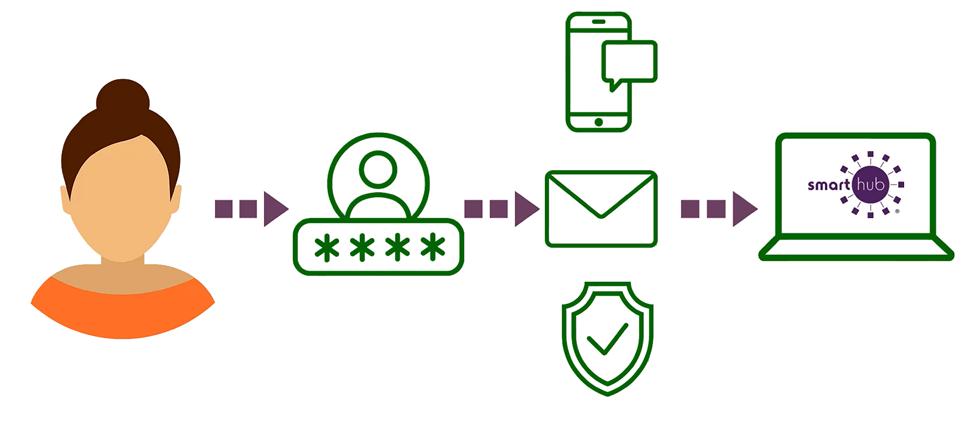
Activating two-factor authentication on your SmartHub account will help protect your information. You have the option of using text, email, or a code generation app to implement 2FA security.
numbers and symbols. Do not use common words, personal information, or simple sequences like abcde or 12345.
• Use a different password for every account. If you use the same password for multiple accounts, if a hacker compromises one they will have access to all.
• Be vigilant when reading emails or texts. If messages have poor grammar, you don’t know the sender, it conveys a sense of urgency, or it sounds too good to be true, be cautious. If you think the message may be legitimate, contact the sender directly using another means. Don’t reply to a suspicious message.
• Keep your device, security software, and apps up to date. Cybercriminals and defenders play a constant game of cat and mouse. As hackers find a way around security protocols, defenders must find new ways to stop them.
MONTHLY CALENDAR & CO-OP PHOTO CONTEST WINNER
August 8 – EEA board meeting begins at 8:30 a.m. at its headquarters in Cortez. The agenda is posted 10 days in advance of the meeting at eea.coop. Members may attend in person or remotely. Instructions to attend remotely are included on the agenda.
God’s Beauty by Autumn Brown

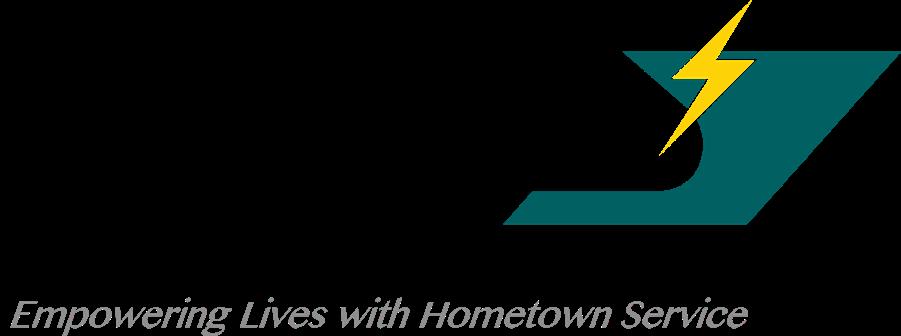


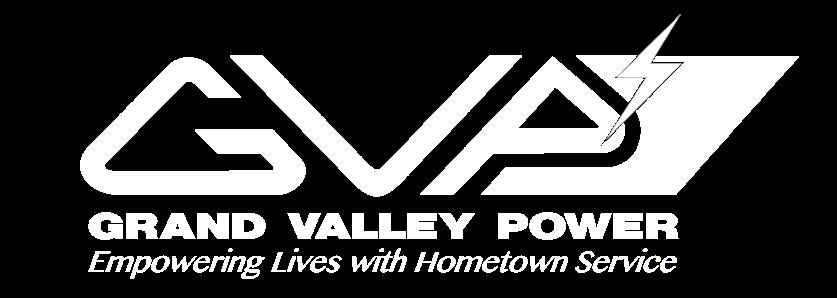


G2,000 Members Help Grand Valley Power Save Big
You can help, too
By Tom Walch Chief Executive Officer
rand Valley Power is a cooperative. Member owned. When we save, you save. We’re dedicated to doing the right thing, and delivering value to all we serve, even in tough economic conditions.
Last year, power costs climbed higher than anyone expected. At the same time, Grand Valley Power sold fewer kilowatt hours — which meant revenue for the year was lower than projected. But even in a tough year, we hit or exceeded our financial targets. We increased the amount of equity (assets minus liabilities) on our books to more than 40%, and did not raise rates.
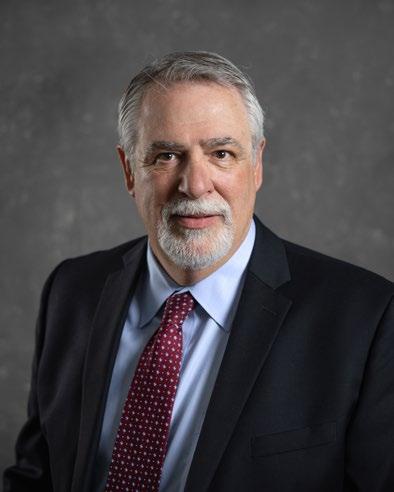
not mail them a bill. No paper statements. No return envelopes. No postage.
That may not sound like much, but it adds up fast. As a bonus, these members are not subject to the mercy of the U.S. Postal Service.
How did we do it? A large part of the credit goes to the cost-conscious mindset of Grand Valley Power’s team members. They found ways to save internally while continuing to deliver safe and reliable electricity to our members without compromising service. It’s a testament to the values that our employees uphold — accountability, stewardship, and service.
But as much as we do, you can help us do more.
SAVING STARTS AT THE MAILBOX
More than 2,000 Grand Valley Power consumers participate in paperless billing and automatic bank draft payments. These members quietly help the cooperative reduce operating costs simply by asking us to

And the cost savings extend beyond postage and paper to check processing. Every month, GVP processes some 3,600 paper bills. That means our employees have to open 3,600 envelopes and handle 3,600 paper checks. The single most expensive component of payment processing is a check that doesn’t clear. The second most expensive? I’ve always heard that it is a check that does clear. This is expensive because paper checks require multiple staff members to manually handle a single piece of paper.
Compare that to automatic bank draft payments, or electronic funds transfers. EFTs cost Grand Valley Power next to nothing to process. One employee can transfer an electronic file and process thousands of payments with minimal effort. It is secure, and it doesn’t cost the consumer anything. Credit card payments, by contrast, come with a roughly 3% fee. On an average residential electric bill, that’s about $4 per transaction. Last year alone, credit card fees cost GVP nearly $453,000.
That’s money we absorb as a business — something we’ve always considered to be a cost of doing business. But every cost must be covered — ultimately
845 22 Road | P.O. Box 190 Grand Junction, CO 81502
970-242-0040 | communications@gvp.org gvp.org facebook.com/GVRuralPower
in the rates that members pay. A big trend among companies is passing credit card fees directly to consumers. We haven’t taken that step — yet!
EFT, on the other hand, offers a perfect balance: it’s convenient, secure, dependable, and practically free for the co-op. That’s why we’re encouraging more members to make the switch — and we’re going to reward those who do.
SHARED SAVINGS: ONE YEAR, ONE CREDIT
Grand Valley Power’s Shared Savings program is simple. Sign up for the program and enroll in paperless billing and/or automatic bank draft EFT payments. If you stay enrolled for 12 consecutive months, we’ll share the savings with you by way of a bill credit at the end of the term.
This program reflects our long-term commitment to efficiency and fairness. It’s not a gimmick. It’s a way
Shared Savings
Two Options
for our members to help us reduce costs across the board and share in the savings.
SMALL CHANGE, BIG IMPACT
Paperless billing and EFT payments aren’t just more sustainable — they’re smarter. They save you time. They save us money. And they ensure that we can continue to provide reliable electric service without passing unnecessary costs on to the membership.
If just a few thousand more members make the switch, we could save tens of thousands of dollars more each year and build a stronger cooperative for everyone.
It’s one of the simplest ways to make a difference. And it comes with a big reward.
Sign up for Shared Savings today. One year. One credit. One simple way to support your cooperative.
Sign up for both paperless billing and automatic bank draft payments (EFT) for 12 consecutive months and get a $50 bill credit at the end of the term.
Sign up for either paperless billing or automatic bank draft payments (EFT) for 12 consecutive months and get a $25 bill credit at the end of the term.
How to Sign Up:
1. Call Grand Valley Power at 970-242-0040 or complete the brief online form at gvp.org/sharedsavings.
2. Enroll in paperless billing and/or automatic bank draft payments (EFT). You can enroll in both through SmartHub at gvp.smarthub.coop or by calling us at 970-242-0040.
Terms & Conditions Apply (Visit gvp.org/sharedsavings for complete details):
• Limited time offer available exclusively to members on the GS-TOU (General ServiceTime-of-Use) rate.
• Members must notify GVP of their intent to enroll in the Shared Savings program by completing the online form at gvp.org/sharedsavings or by calling GVP at 970-242-0040.
• Only ONE credit per member. If a member has more than one GVP account, all accounts must be enrolled to be eligible for a bill credit. Members whose accounts become delinquent are immediately ineligible for the EFT bill credit.

TIME-OF-USE SUMMER SAVINGS TIPS
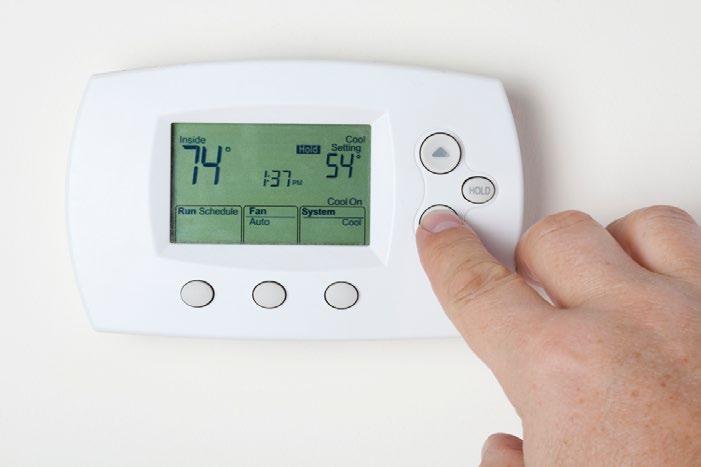

T H E R M O S T A T
I f y o u h a v e a s m a r t
t h e r m o s t a t , p r o g r a m i t
t o a h i g h e r t e m p e r a t ur e
w h i l e y o u a r e a w a y . P r e -
c o o l y o u r h o m e d u r i n g
t h e o f f - p e a k h o u r s f o r
e v e n h i g h e r s a v i n g s .


A P P L I A N C E S
W a s h f u l l l o a d s o f l a u n d r y o r d i s h e s p r i o r t o 4 p . m . o r
s e t y o u r d i s h w a s h e r t o r u n a f t e r 9 p . m . S w i t c h t h e
w a t e r t e m p e r a t u r e t o
w a r m i n s t e a d o f h o t f o r
a d d i t i o n a l s a v i n g s !

O U T D O O R C O O K I N G

G e t c o o k i n ’ g o o d
l o o k i n ’ ! U s e y o u r g r i l l t o
r e d u c e t h e e n e r g y a n d
h e a t p r o d u c e d b y
k i t c h e n a p p l i a n c e s . T h i s
w i l l k e e p y o u r h o me
c o o l a n d e n e r g y b i l l l o w .
W h e n m e m b e r s u s e e n e r g y i s j u s t a s i m p o r t a n t
a s h o w m u c h i s u s e d !
O F F - P E A K = E l e c t r i c i t y r a t e s a r e l o w e r d u r i n g “ o f f - p e a k ” h o u r s
( b e f o r e 4 p . m . a n d a f t e r 9 p . m . ) w h e n e n e r g y d e m a n d i s l o w e r .



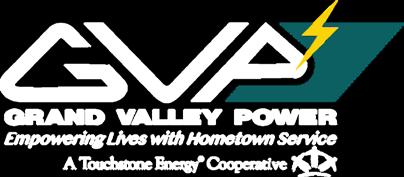


DO WE OWE YOU MONEY?
If you buy your electricity from Grand Valley Power, then you are a member of our cooperative. One of the many benefits of cooperative membership is that over time, members receive unused revenues, also known as excess margins, in the form of a payment we call CashBack Credit Checks. These payments were mailed in December to both current and past cooperative members. Unfortunately, we can’t always find everyone who has earned a CashBack credit if we do not have their correct address. We

2025 Director Candidates
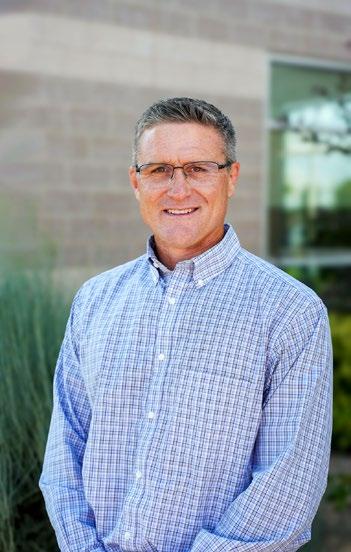

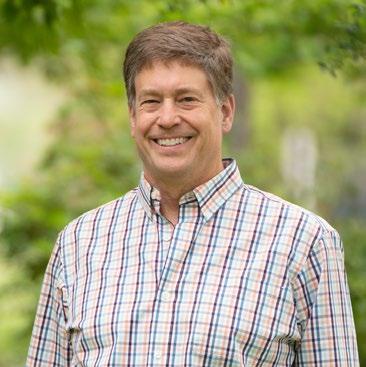
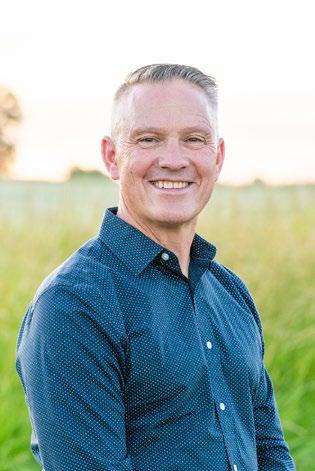

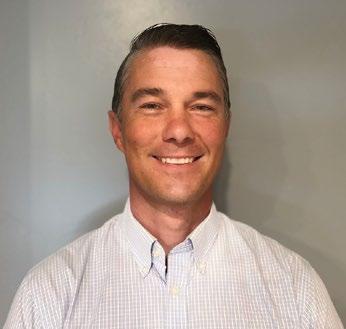
KYLE COLTRINARI
GARY DE YOUNG
ANDREW GOLIKE
MICHAEL SHIDELER
1. No purchase necessary.
Happy Birthday Willie Wiredhand! Coloring Contest Entry Form
Rules and Instructions
See the prize list on our webpage: gvp.org/coloringcontest Let’s celebrate Willie’s 75th Birthday in October
2. Open to all ages. One entry per person.
3. Coloring contest entries are due no later than 5:00 p.m. MST on August 29, 2025.
4. Drop off your submission at Grand Valley Power | 845 22 Road | Grand Junction, CO 81505
5. Entry MUST include the entry form (below) to be considered complete.
6. Entry artwork MUST be original and created by the entrant.

7. First and second places will be announced for each age group. From those, the grand prize entry will be selected and used as the October 2025 Colorado Country Life magazine cover art.
8. Winners will be announced on September 10, 2025 via Facebook and Instagram. The name and age of the winners will be posted on the Grand Valley Power website and social media channels.
9. All entries become the property of Grand Valley Power and may be used or reproduced in any manner and for any purpose by Grand Valley Power without additional consent and will not be returned.
10. Grand Valley Power is not responsible for lost, late, or incomplete entries.
First Name: ________________________________ Last Name: _________________________________ Age: ________
Address: __________________________________________________________________________________________
City: ________________________________________________
State: _______________ Zip: _____________________
Phone: ______________________________________________ Email: ________________________________________
Age Division:
If participant is a minor, please fill out information below:
Guardian’s Name: ___________________________________________________________________________________
Guradian’s Phone: __________________________________________________________________________________
Guardian’s Email: ___________________________________________________________________________________
Relationship to Participant: ___________________________________________________________________________
Acknowledgements:
I acknowledge that this entry is original artwork completed by myself or the participant.
I acknowledge that this entry will become the property of Grand Valley Power and may be used or reproduced in any manner and for any purpose by GVP without additional consent and will not be returned.
I acknowledge that GVP is not responsible for lost, late, or incomplete entries.
I grant GVP the right to use contest winner’s first name and age in connection with this coloring contest.
By signing below, you understand the contest rules and regulations. Any entries missing any information including the entry form will be disqualified.
Signature: ___________________________________________________________ Date: ________________________
Guardian’s Signature: _______________________________________________________ Date: ____________________


Building a Smarter Co-op
By Matt Feier Strategy Execution, Technology, and Member Experience Manager
Cooperatives around the world, including GCEA, operate according to a set of seven core cooperative principles. These seven principles applied together make the cooperative business model unique from other electric utilities and greatly benefit GCEA’s members.
The fifth cooperative principle — Education, Training, and Information — encourages cooperative members, the board, and staff to develop, grow, and advance strategic priorities both within their communities and across the electric industry as a whole.
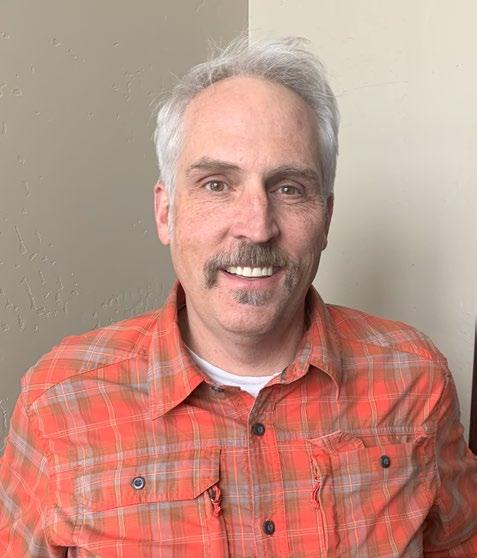
GCEA grows and sustains member and community education by regularly hosting informational meetings and events including Coffee with Your Co-op, Brats and Kilowatts, EV Ride and Drives, Climate Action Coalition quarterly meetings, and our annual meeting. GCEA also offers home energy evaluations that provide detailed information to members on their home energy use patterns, available beneficial electrification technologies, and GCEA’s applicable electrification rebate offers.
Each summer, GCEA promotes member education by sending younger members to the Electric Cooperative Youth Tour in Washington, D.C. On this trip, students learn about cooperative principles, history, governance, operations, and leadership. These young leaders also have opportunities to meet our U.S. Senate and House representatives, meet peers from other electric cooperatives throughout the United States, and tour amazing national museums and historic sites in Washington, D.C. GCEA also sends students to Cooperative Youth Leadership Camp held at Glen Eden Resort near Steamboat Springs. There, they learn leadership skills and develop an understanding of the cooperative business model.
GCEA also encourages member education through monthly e-newsletters informing members of upcom-
ing events, ongoing projects, and the cooperative’s goals and achievements. GCEA’s website is a valuable resource for billing, payment, and other account information, as well as energy-efficiency tips and rebate opportunities. In addition to these initiatives, GCEA members are always invited to our monthly board meetings to voice their ideas and learn more about GCEA’s operations and projects.
For staff and board members, GCEA encourages approved cooperative trainings and certifications. Our lineworkers regularly attend training at Mesa Hotline School. Accounting and billing staff may attend National Information Solutions Cooperative’s Member Information Conference or Co-op U, an intensive accounting training program sponsored by the National Rural Utilities Cooperative Finance Corporation. Board members are required to receive their Credentialed Cooperative Director certification from the National Rural Electric Cooperative Association, and information technology staff may attend National Rural Electric Cooperative Association’s CyberTech conference, a weeklong forum solely focused on cybersecurity within the energy industry. Executive staff may pursue a nationally recognized management internship program, and metering and engineering staff have multiple continuing education and training requirements.
With all of these training and educational opportunities, GCEA is building a smarter co-op, one effort at a time. We appreciate you taking the time to engage with your rural electric cooperative and educate yourself about all the benefits of your GCEA membership. We look forward to seeing you at a future board meeting or community event, and invite you to visit with us at our Gunnison or Crested Butte offices.
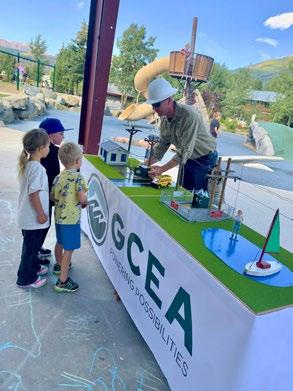
ON THE COVER Crested Butte Journeyman
Photo by Alliy Sahagun
Educating the Next Generation Young co-op members are our future
By Alliy Sahagun Member Relations Supervisor
As I write this article, we are coming off GCEA’s 86th annual meeting and reflecting on the highlights of another celebration with our members. This year felt different; we all sensed a new kind of energy coming out of a fun-filled evening full of bucket truck rides, high-voltage demonstrations, EV conversations, visiting with friends and neighbors — and, of course, the prizes.
What made the difference? Our youth.
GCEA’s Last Chance Scholarship opportunity, along with family-friendly activities and prizes, drew a crowd of new faces to the annual meeting this year. It was rewarding to educate everyone about what it means to be a member of a rural electric cooperative.
I feel that same excitement every time I leave a school after an Electricity 101 presentation with GCEA’s linemen or after interviewing students for one of our youth trip opportunities. Helping young people understand where their power comes from and how to use it responsibly is incredibly rewarding. I’ve even had children run up to me in the grocery store to proudly announce that they now turn off the lights when they leave a room — because we taught them about energy conservation in their classroom.
Why does GCEA invest in education? Because we are dedicated to preparing the next generation of informed, engaged citizens who become more energy-conscious at home and in the future workforce. When we send students to the Washington D.C. Youth Tour or Leadership Camp in Steamboat Springs, they learn about government, history, and the cooperative business model. Participants meet with lawmakers, visit national landmarks, and connect with peers from across the country. These experiences often inspire students to pursue careers in public service, energy, or cooperative leadership.
Thanks to unclaimed capital credits and generous contributions from Basin Electric, Tri-State Generation and Transmission Association, GCEA members, and our board of directors, GCEA’s younger members have the opportunity to earn scholarships towards higher education. These scholarships are available to students pursuing academic and vocational paths. By
investing in students’ futures, GCEA helps ensure that our rural community remains vibrant and resilient.
The goal of these efforts is twofold: to support local youth and to cultivate future co-op members and leaders who understand the value of cooperative principles—like democratic member control and concern for community. When young people understand how their local electric cooperative operates, they are more likely to participate in meetings, vote in board elections, and contribute to the long-term health of their co-op.
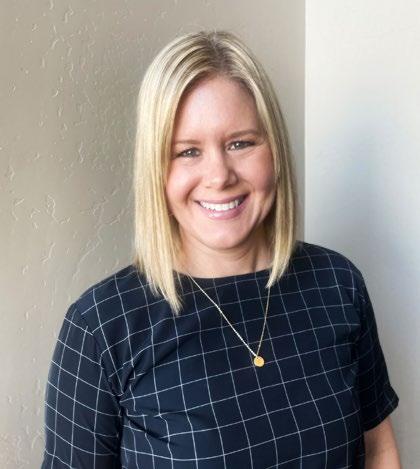
By educating and empowering our younger members, GCEA is planting seeds for a brighter tomorrow. Whether it’s through energy education, leadership development, or financial support, these programs ensure that our youth are informed, inspired, and ready to power the future. We know our future depends on the next generation. That’s why we work hard to create opportunities for local students to learn, grow, and lead.
To learn more about our student opportunities, visit gcea.coop/community. Follow us on Instagram and Facebook to see updates on this year’s student trips.
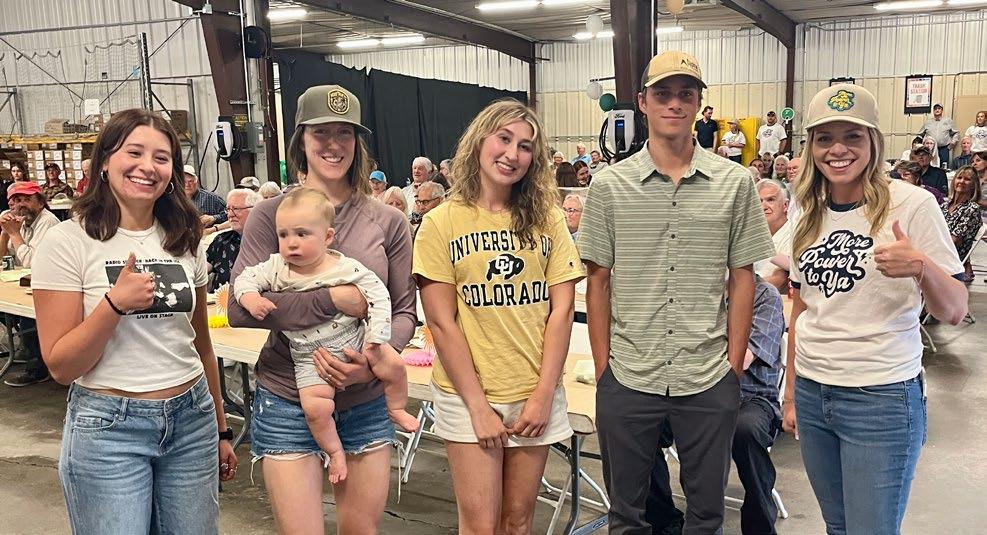
Left to right: Last Chance Scholarship winners Dakota Sahagun, Clare Charsley-Groffman, Danielle Dempsey, Sam Bullock grab a photo with GCEA Communications and Outreach Coordinator Logann Long at the Annual Meeting.
Local Students Return from Washington D.C.
Seven local students recently returned from the Washington D.C. Youth Tour, a weeklong, all-expenses-paid trip sponsored by GCEA and organized in partnership with the Colorado Rural Electric Association, the National Rural Electric Cooperative Association, and the Colorado Electric Educational Institute. The trip took place in June and gave students the opportunity to explore our nation’s capital while learning about leadership, government, and the cooperative business model.
This year’s participants were Cody Pleak, Colby Smith, Oskar Campo, Ruby Nornes, and Mylee Clifton of Crested Butte and Ava Witzel and Caleb Woodward of Gunnison.
Thank you for this life-changing experience! Through this trip I have gained a greater understanding of what co-ops do for our communities. I have also gained a deeper knowledge of the foundations of this country.”
— Mylee Clifton
The journey began in Denver where students met with state officials and toured the Colorado State Capitol. They then joined other students from Colorado and Wyoming before flying to Washington, D.C. Over the week, the group visited landmarks such as the United States Capitol, Mount Vernon, the Library of Congress, and various memorials, museums, and cathedrals.
GCEA is proud to make this experience possible each year through unclaimed capital credits — funds returned when members’ capital credit checks go uncashed or are undeliverable. GCEA’s board of directors allocates these unclaimed funds to support education and community initiatives, including sponsorship of the Youth Tour.
Interested in next year’s trip? Applications will open this fall. Learn more online at gcea.coop.
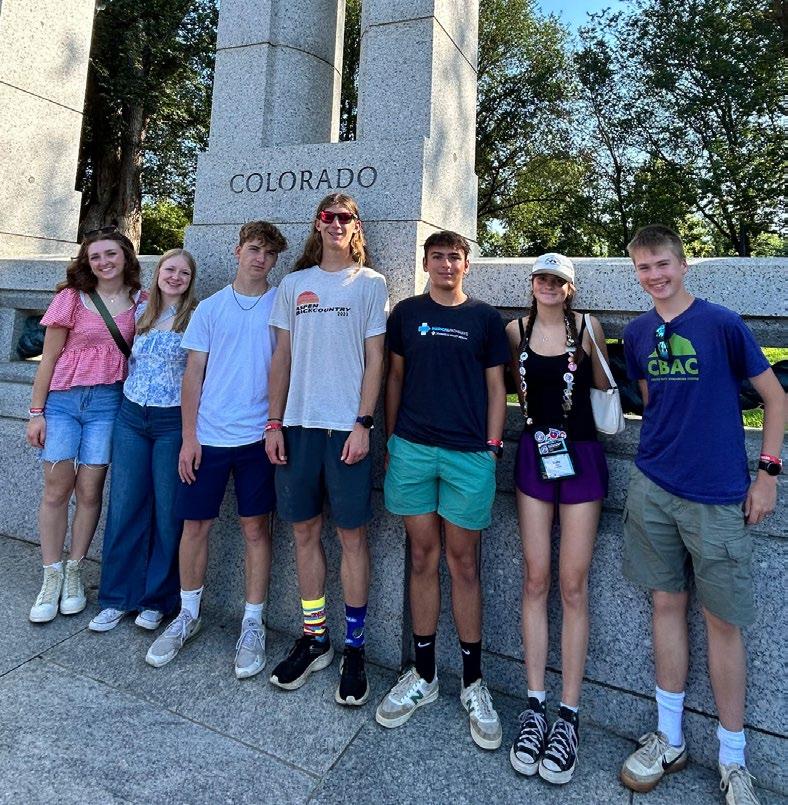
GCEA AWARDS 129 SCHOLARSHIPS FOR THE 2025–2026 SCHOOL YEAR
This year, GCEA awarded 129 scholarships to deserving students in our service territory.
Thanks to the support of unclaimed patronage capital, generous members, the Somrak and Drake families, Tri-State Generation and Transmission, Basin Electric Power Cooperative, individual board directors, and GCEA employees, we are proud to continue our tradition of supporting local students through scholarships.

To view the full list of scholarship recipients, scan the QR Code.
Left to right: Mylee Clifton, Ava Witzel, Caleb Woodward, Cody Pleak, Colby Smith, Ruby Nornes, and Oskar Campo visit Washington, D.C., as part of the Electric Cooperative Youth Tour.

College Dorm Room Electrical Safety
As students head off to college, it’s important to keep electrical safety in mind — especially in shared dorm spaces. Always unplug devices when they’re not in use and report any electrical issues to campus maintenance immediately. A few simple precautions can help prevent fires and keep students safe all year long:
1. Don’t overload outlets; use surge-protected power strips.
2. Use only approved appliances — check with your college for what’s allowed.
3. Keep cords neat and visible. Do not run them under rugs or beds.
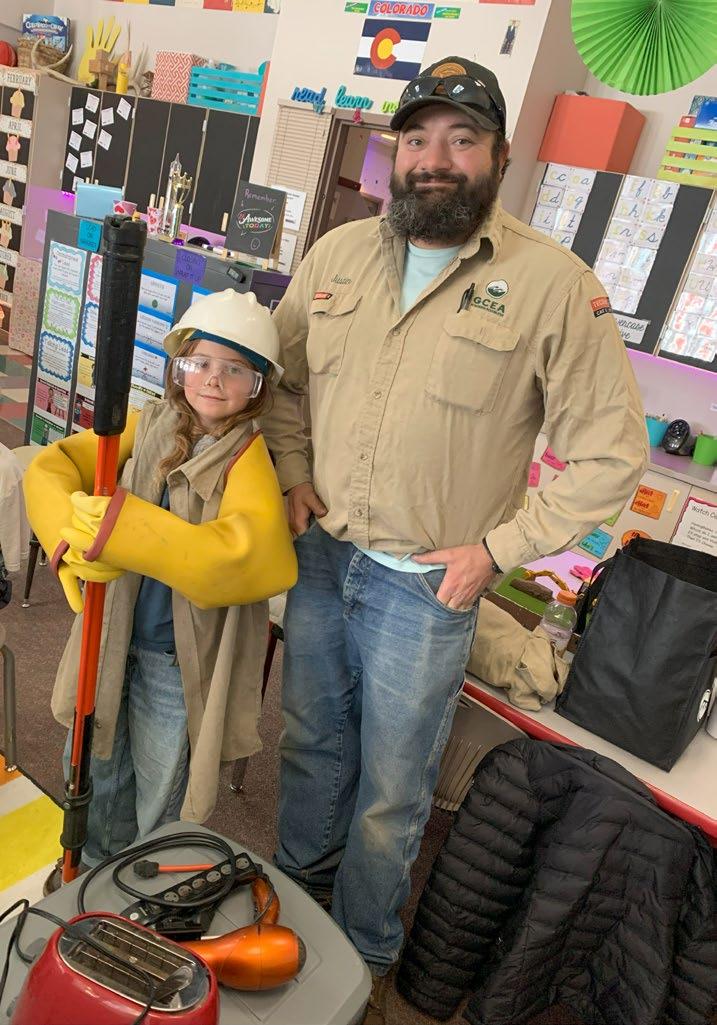
4. Never block fire sprinklers or exits.
5. Know your escape plan and familiarize yourself with fire exits and drills.
6. Don’t leave cooking unattended. If you’re allowed a microwave or kettle, stay nearby.
7. Lock your doors and always secure your room when you leave or go to sleep.
8. Report maintenance issues like exposed wires, leaks, or broken smoke detectors. These should be fixed immediately.
9. Avoid candles and open flames; use battery-powered alternatives instead.
Stay smart, stay safe, and enjoy campus life!
ELECTRICAL SAFETY FOR EVERYDAY LIFE
Electricity powers our homes, workplaces, and lives — but it must be used safely. At home, avoid overloading outlets and always unplug appliances when not in use. At work, follow all safety protocols and use equipment properly. Outdoors, stay clear of downed power lines and call before you dig. Teach kids to never play near electrical equipment. Always hire qualified electricians for repairs. Simple habits like these can prevent serious accidents and keep everyone safe around electricity.
Want to Learn More About Electricity and Safety?
GCEA Can Teach Your Group!
Gunnison County Electric Association is here to help you understand where your electricity comes from — and how to use it safely and efficiently. We offer free presentations for all ages and groups in our community, including local schools, civic and community groups, EMS teams, fire departments, and law enforcement groups.
Whether you’re teaching kids about power lines or training first responders on electrical hazards, GCEA has a program for you.
Ready to schedule a presentation? Give us a call at 970-641-3520 and let us bring the power of knowledge to your group.
GCEA Journeyman Lineman Justin Hulick helps a student get a feel for lineman gear during a school visit

Smart Home Technology
Three ways to save energy
Smart technologies make our homes more comfortable, convenient, and energy efficient. By connecting to your home Wi-Fi network, smart devices automate everyday tasks like lighting, heating, cooling, and home security — they can even communicate with other smart devices in the home.
While not all smart home products are specifically designed with energy savings in mind, there are several smart technologies that can help you lower home energy use. Here are the top three smart home devices that help you save.
SMART THERMOSTATS
Smart or not, your thermostat is the most effective tool for controlling energy use — heating and cooling typically account for the largest portion of energy bills. Smart thermostats allow you to adjust the indoor temperature through an app, giving you full control from anywhere on the go. Many smart thermostats include learning capabilities and will adjust the temperature based on previous behavior and patterns.
According to the U.S. Department of Energy, smart thermostats can reduce heating and cooling bills by more than 8% annually. With models costing as low as $65, they typically pay for themselves in one year.
SMART LIGHTING
Smart LED bulbs use less electricity than traditional bulbs and can be scheduled and operated remotely through a smartphone app. Smart bulbs are available in a range of shapes, brightness levels, colors, and more.
Many smart bulbs include motion sensors that turn on or off based on room activity, further optimizing home energy use. If you’re new to smart lighting, try a home starter kit. Prices for kits range from $70 to $300 or more, depending on how many bulbs you need.
SMART PLUGS
Smart plugs are inexpensive gadgets that can help you save energy. Many electronic devices consume power even when they are turned off — known as phantom load — which can take a toll on your energy bills. Smart plugs are simply plugged into an electrical outlet and connected to your Wi-Fi network. When set up, the smart plug can cut power to non-smart devices, like coffee makers, phone chargers, and other items that draw phantom load.
Many smart plugs can be paired with popular smart hubs, like Alexa or Google Nest, or controlled through the plug’s associated app. Smart plugs are simple to use and a set of four can be purchased for as little as $25.
If you’re looking for new ways to save energy, try these budget-friendly and convenient smart home technologies. To help get you started, GCEA has a gift for you. Visit our office today to receive a free gift bag with a smart plug, power bank, and tips on how to lower your peak demand.
For more information on GCEA’s upcoming rate change, visit us online at gcea.coop
GCEA’s upcoming rate change puts the power in your hands — letting you take charge of how and when you use electricity. With smart technologies, you can manage your energy use more easily and even save on your electric bill.

Net Metering
What is it and how does it work?
By Dennis Herman General Manager
Residential solar power systems are becoming more attainable, and more homeowners are exploring solar panels as an additional source for powering their homes. The amount of electricity produced by solar panels depends on several factors, including your location’s sunlight exposure and the number of panels installed. In many cases, solar panels can generate an adequate amount of electricity to power your home.
WHAT IS NET METERING?
Highline Electric Association offers a net metering program, which compensates solar owners for the energy the system produces. If a solar system generates more power than the home requires — typically during peak sunlight hours — the additional energy is fed back into the electric grid. In return, the homeowner will receive a credit on their energy bill, and potentially accumulate kilowatt-hour credits towards their “bank” for the excess energy. This billing arrangement is known as net metering.
HOW DOES HEA KNOW HOW MUCH TO CREDIT FOR THE EXCESS POWER?
When solar panels produce less electricity than the home requires, the electric meter runs “forward,” just as it would on a home without solar panels. But when the solar system generates more electricity than needed, the electric meter runs “backward,” and the excess power is sent back to the grid. At the end of the billing cycle, you are charged for the net total energy used from the electric grid.
It is important to understand that the amount of electricity you use does not include the full cost of

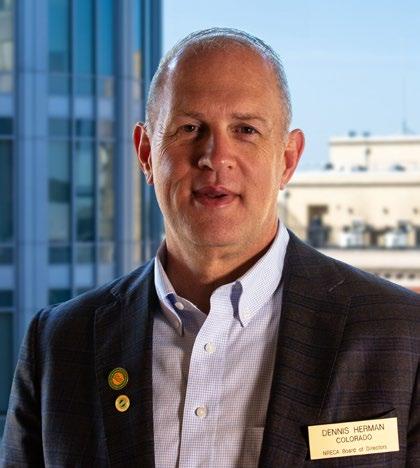
maintaining grid infrastructure that supports your home year-round. This is why you will typically see charges in addition to net use that help maintain reliable electric service, such as grid infrastructure maintenance, transformer upgrades, and system monitoring and balancing.
Net metering can lower your bill throughout the year. As solar production is typically higher during summer months and lower during winter months, net metering allows solar system owners to earn credits and accumulate an energy “bank” during the high-production months. You can use those credits later in the year when solar production is lower.
WHO USES THE EXCESS POWER GENERATED BY THE SOLAR SYSTEM?
The electricity produced by solar does not go directly to your neighbors. The power flows back to the local grid managed by HEA. We then apply the credits for any excess power you have contributed.
While generating electricity from the sun and sending excess power back to the grid is an exciting opportunity, it is important to thoroughly research the details before installing solar panels or any other type of small-scale renewable energy system.
HEA members who install solar and participate in net metering will need to submit an application, provide system design and specifications, sign an interconnection agreement, and get the completed system inspected by their state electrical inspector.
Work with a reputable solar vendor to ensure generation estimates are realistic and that your home is equipped for the system. HEA can recommend local
1300 S. Interocean P.O. Box 57 Holyoke, CO 80734-0057
phone 970-854-2236 toll free 800-816-2236
Holyoke & Sterling: M-Th 7 a.m.– 5:30 p.m.
info@hea.coop hea.coop facebook.com/HighlineElectric
Ovid: Mon., Tues., Thurs. 9 a.m.–3 p.m.
contractors we have worked with successfully based on your location.
It is important to note that net metering will not eliminate your energy bill. Even if you generate as much electricity as you use, which is rare, you will continue to be billed for the service fees and demand
more about net metering, HEA can help. By connecting with us first, you will gain a better understanding of the solar energy system, the process to interconnect, billing procedures and estimates, and more. Please contact HEA Member Services Manager Tad Huser at 970-854-2236.
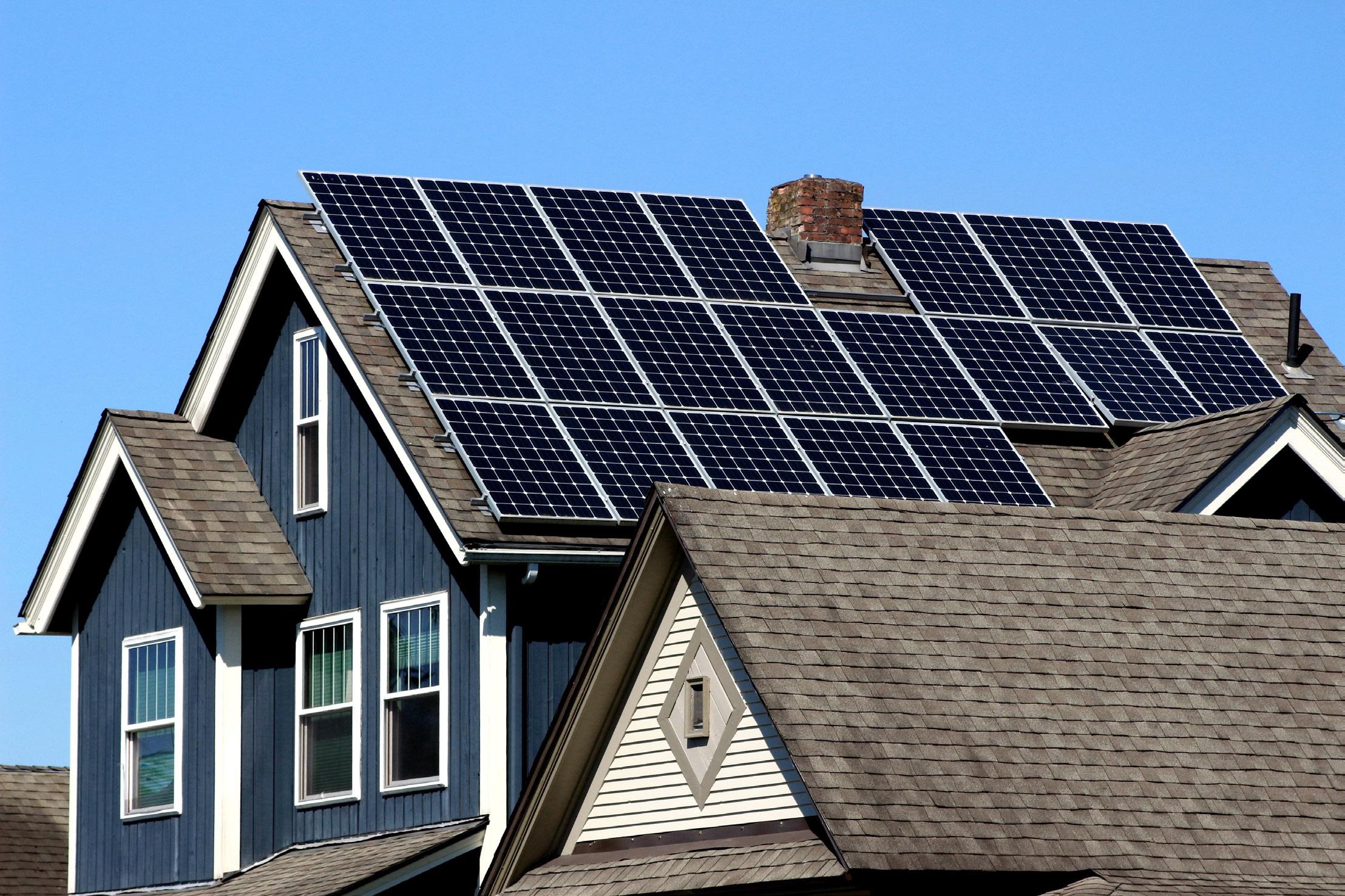
UNDERSTANDING NET METERING
1. A privately-owned, residential solar panel system converts energy from sunlight into electricity.
2. An inverter, which is connected to the electric grid, converts the electricity from direct current (DC) to alternating current (AC) to make it safe for use in homes.
Net metering is a billing mechanism that compensates consumers who own residential solar panels for any excess power sent back to the electric grid.
3. The electricity is used to power the home. (It should be noted that solar panels do not provide electricity during a power outage.)
4. If the panels produce more electricity than the home needs, the consumer is compensated for excess electricity sent back to the grid
Note: Factors such as solar power system ownership and state-specific laws can impact net metering policies. Contact Highline Electric Association if you have questions about net metering.
JOIN HIGHLINE ELECTRIC FOR HOT DOG
WEDNESDAY!
Visit Highline Electric’s Holyoke office at 1300 S. Interocean on August 6 for a free hot dog lunch!
The co-op is partnering with the Holyoke Chamber of Commerce and STAR 92.3 FM to bring the community together over lunch.
Join us from 11 a.m. to 1:30 p.m. for a free hot dog, chips, and a drink. You will also be able to see Highline’s high-voltage demo and learn about the co-op’s new On-Bill Repayment program.
We look forward to seeing you!

Is Your Name Below?
Below is a list of names of Highline Electric Association members who have unclaimed capital credits from the electric cooperative.
HEA publishes the unclaimed capital credit list every year to notify HEA members that the co-op has issued them a capital credit check and that the check has not been cashed.
Look for your name in the printed list below. If you are a current or former HEA member and find your name, email capitalcredits@hea.coop or call 970-854-2236. Names will continue in next month’s Colorado Country Life magazine.
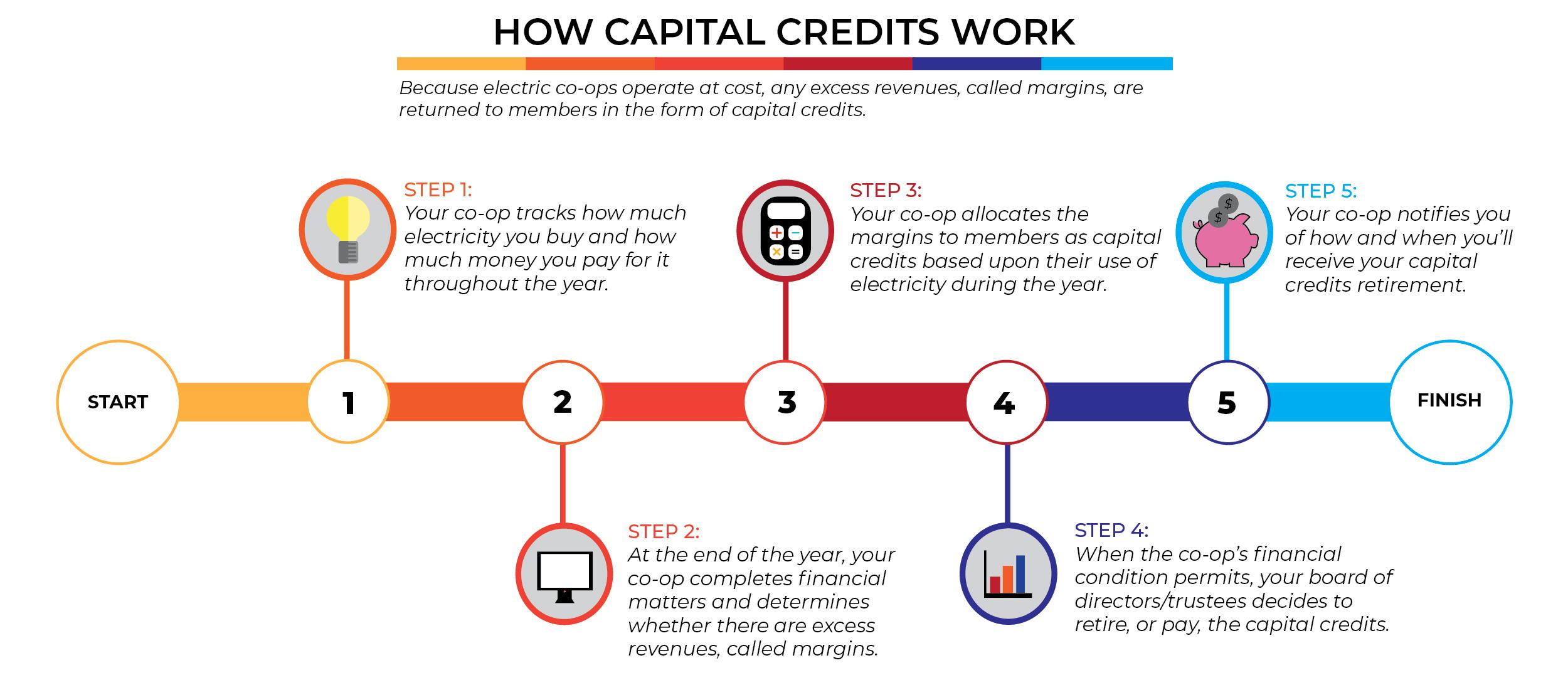
ABBOTT, PAM
ABERNATHY, BRETT
ABTS, DANI
ABTS, KEN
ABTS, KEN & HEATHER
ABTS, MARY J
ACHEN, NORA JEAN
ADAMS, VIRGINIA
ADLER, JAKE
ADMIN, FARMERS HOME
ADYE, JULIE A
AGRI-FEEDERS, SOUTH PLATTE
AGUILAR, HILARIO
AGUIRRE, LETICIA
AHLGREN, HARRY & JOAN
AHNSTEDT, GERALDINE MAE
AKERS, JOHNNY L
ALBER, ELNORA L
ALBERS, JAMES M
ALBERTSON, HARRY L
ALBRANDT, THOMMI
ALBRECHT, EDWARD
ALCORN, SAM L
ALLEN FARM, NORMA JEAN POTTER
ALLEN, ANN DAXTON
ALLEN, DANITA
ALLEN, DENNIS
ALLEN, EDGAR D
ALLEN, JEFF
ALLENDORF, DUANE
ALVAREZ, JOE M
AMADOR, ARDIE
AMEN, DAVID & JACOB
AMESBURY, DANIEL
ANASTASSIA, ANCONA, TERRY
ANDAVAZO, MANUEL
ANDERLE, BENNIE
ANDERSEN, BYRON R
ANDERSEN, DEBBIE
ANDERSEN, KARYN L
ANDERSON ESTATE, JENNIFER
ANDERSON, BILL
ANDERSON, DAVID L
ANDERSON, DON
ANDERSON, JACKIE
ANDERSON, MONTY
ANDERSON, PAUL
ANDERSON, RANDALL G
ANDERSON, RON
ANDRES, MIKE
ANKENEY, CAROLINE
ARENA, CROOK RECREATIONAL
ARMSTRONG, GRACE
ARMSTRONG, SCOTT
ARNOLD, CHARLES & KRISTI
ARVISO, ARMANDO
ARVIZO, JERESEL
ATKINS, KATHY
ATTCO
ATWOOD, LARRY
AUSTILL, CAROL
AWS
BABCOCK & BROWN ENERGY
BADE, STEVE R
BAILEY, DEBORAH
BAILEY, STEVE
BAK, DORIS JEAN
BAKER, CHASE
BAKER, JOE P & BARBARA L
BAKER, TRACY
BALL, SARA
BALL, SHANA
BALLARD, STEPHANIE
BANE, DAISY
BANE, DAVID
BANEY, BART
BANK, CENTURY
BANK, FIRSTIER SAVINGS
BAPTISTA, STEVEN
BARAY, LUIS
BARBER, PAM
BARBMOORE, DUANE K
BARDEN, JACQUELINE J
BARE, SKYE L
BARGER, CHRIS
BARKLEY ESTATE, ERIC W
BARKLEY, FRANCES
BARNARD, ROBIN E
BARNES, MELINDA
BARNETT, DAN
BARRETT, ART
BARRETTE, HOPE
BARROWS, DANIEL
BARTELS, A E
BARTON, DARREN R
BASEGGIO, VINCENT & LAWRENCE
BASHAM, KATHERINE
BASS, DAN
BASS, PAUL
BASSETT, FRANCES
BATTY, PAUL J
BAUCKE, EDWIN L
BAUER, KENNETH L
BAUER, M SCOTT
BAYSIDE MARINA
BEAMER, KEITH
BEAUCHAMP, MATTHEW
BECKER, GIB D
BECKER, LINDA M
BEEDE, CRAIG
BEELER, JAMES R
BEEMER, JERRY R
BEGIN, DARLENE M
BEISNER, ANDREA
BEJARANO, EMMANUEL
BELL, DAVID V
BELL, DWANE OR MARY BELL, LOIS M
BELLENDIR, ANTHONY
BEMUS, MELISSANNE
BENCOMO, ERBEN
BENNETT, TRAVIS
BENSON, CURTIS
BENSON, PAULINE L
BERG, RICHARD J
BERG, TED
BERGES, TONY LEE
BERRY PETROLEUM
BERRY, WAYNE L
BEST, PHILIP N
BEUTLER, T SCOTT
BIERMAN, JAMES F
BILGER, KEVIN
BILLINGER, TONYA
BINGHAM, JOHN BRUM & BETTY
BIRCH EXPL LTD LIABILITY CO
BIRGE, STEVE
BIRKBECK, JERED & LAURA
BJL HOLDINGS LLC
BLAKE, CASEY
BLANKENSHIP, ROBERTA
BLEDSOE, HENRY A
BLUE BIRD MOBIL HOMES INC
BLUE RANCH LLC
BODEN, LAVERN F
BOEHM, PAUL
BOEKHOUT, TED
BOHLENDER, DANETTA
BOHLENDER, JAY & MARY M
BOLIN, RODNEY & TIFFANY
BOLTON, LANCE & LORRIE
BOLTZ, TOREY
BOND, DENNIS L
BONNE, SHIRLEY
BOPPRE, SUSAN
BORNMAN, JOHNNY
BOSCHEN, MARY L
BOSTRON, JOHN
BOSTRON, PHIL A
BOURNE, MARCUS
BOWER, DAVID
BOYER, DAVID
BOYLES, MICHAEL
BRACKEN, HOPE
BRADLEY, DEBRA
BRADLEY, MARK
BRADLEY, TINA
BRAKHAGE, KRISTA M
BRANDT, AGATHA
BRANDT, JOHN F
BRANT, MICHAEL
BRAUER, DOUGLAS R
BRAZ, BILL
BREDEHOFT, DEBORA
BREIDENBACH, DOUGLAS D
BRETZ, ROBERT & DIANA
BRIDGERS, ELIZABETH
BRIGGS, CHOD
BRIGGS, MICHELLE L
BRILEY, ROSE
BRINER, MILFORD C
BRINKOPF, WENDY
BRISBY, TAMMIE
BRISCOE, BRITINI
BROCK, WILLIAM P
BROCKBANK, BRIAN
BROOK, JIM
BROOME, ELIZABETH
BROTHERS, MONTEITH
BROTHERS, SCHNEIDER
BROUGHTON, RHONDA S
BROUGHTON, ROLAND E
BROWN, BERNARD K
BROWN, FRANK C
BROWN, JOYCE M
BROWN, PHILIP D
BROWN, RANDY L
BROWN, SUSAN J
BROWN, TOBY R
BRUNKHARDT, MARK D
BRUNS, GEORGE
BRUNS, MARVIN
BRYAN, ROBIN J
BRYANT, TRESSIE
BUCHANAN, DONNA
BUCHANAN, ED & SHEILA
BUCHANAN, JOSEPH R
BUDD, JAMES S
BUEHLER, DENNIS
BUFFALO HILLS SIGN INC
BUFFALO HILLS SIGN
BULLOCK, JASON
BUNNER, JERRY
BURGESS, DUWAYNE G
BURKE, JIM & BAILEY
BURMESTER, TAMIE R
BURNAM, LONNIE
BURNS, DELMAR L
BURTARD, ROB
BURTON, DAVID
BURTON, KAREN
BUSHEFF, LILA MAE
BUSIG, INEZ
BUSS, RAYMOND J BUTLER, H M
BUTTLE, DOROTHY
BYAM, KENIS D
BYERLY, THOMAS K
C F GREEN PACKING PLANT
C QUARTER CIRCLE RANCH INC
CAHOW, ROBERT E CAIN, RAY D
CALFRAC WELL SERVICE
CALLAHAN, CONRAD & STACEY
CALVERT, MAX A CAMPANY, MARK
CAMPBELL, JEFFREY A CAMPBELL, MARCIE
CAMPFIELD, TAMARA S CARLSON, BOB
CARMAN, JAMES D
CARPENTER, WILLIAM S
CARR, MIKE J
CARTER, SAM
CARUSO, RUTH
CARVER, DANIEL & STACIE
CASILLAS, RUBY A CASKEY, HELEN F CASTILLO, MARY M
CASTRO, ROBERTO CAVALLI, PAUL
CAZARES, FABIAN
CENTEX HOME EQUITY CORP CHADA, BETTY L
CHADWICK, ROD OR CAROL CHAMBERS, KEN & SONIA
CHAMPION GROCERY
CHANDLER, WILLIAM CHAPEL, STEVEN G
CHAPMAN, CAROL L. CHARD, PAUL CHARLES, TIMI CHARTIER, BRIAN & PATTI CHRISTENSEN, LORRAINE CHRISTIAN, MARJORY CHRISTNER, JAMES CHRISTOPHER, GERALD CHRISTOPHER, KURT CHURCH, LAMAR CHRISTIAN CLARK, BECKEY CLARK, BRADFORD J CLARK, PAUL CLARK, RAYMOND G CLARK, ROBERT E CLARK, TIM & STEPHANIE CLASON, DENNIS CLAY, ANDY CLEANING, J AND H STEAM CLEAVER, TERRI CLEVELAND, NORMAN CLINKENBEARD, CINDY CLOUSE, KASSIDY CLOUSE, SUSAN CLUB, MERGS UNLIMITED CO, AMOCO PIPELINE CO, ASH & WHITE CONST CO, CAVE RANCH CO, CONTINENTAL OPERATING CO, HAMILTON LAND & CATTLE CO, HARRIS LIVESTOCK CO, HEADINGTON OIL CO, HONDO OIL & GAS CO, KIEWIT WESTERN CO, LEWIS & CLARK EXPL CO, LUNA CONSTRUCTION CO, MOUNTAIN BELL CO, NOLBURN ENERGY CO, SCHEEL INVESTMENT CO, SUN OIL CO, THE HOUSTON EXPLORATION CO, UNOCAL PIPELINE CO, VALLEY IMPLEMENT COAKLEY, LENARD A COCHRAN, VIRGINIA COLETTE, ROXY COLLIER, SHARON COLORADO CONSTRUCTORS INC Congratulations to Jim Jackson who is celebrating six years


We’re Here to Serve You
By David Churchwell General Manager
We’ve all heard the phrase, “We’re here to serve you,” countless times. These words may sound generic, but to us at your local electric cooperative, they mean everything.
K.C. Electric Association was created to serve our community. Back in the day, neighbors banded together and formed our co-op for the common good. In our case, it was the only way the community could bring electricity to the rural areas where there was none. In doing so, K.C. Electric helped the community thrive. That mission-focused heritage is the golden thread that is woven throughout our history.
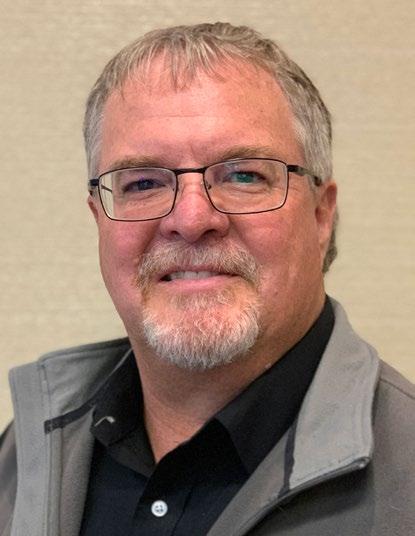
your home or business uses energy can help determine the best ways to modify energy use and thereby keep more money in your wallet. If you’re considering a rooftop solar installation, we are happy to give you an unbiased view of the pros and cons. Investing in a solar power system is a major decision. It is important to fully understand the costs, responsibilities, and potential energy savings. Unlike a solar company that has one objective — to sell their products and services — we will look at the total energy picture and help you determine the best options for your home. We urge you to perform your due diligence and we’re here to help you through that process.
Today, we continue to power the community. While our focus has remained steady on providing reliable energy to our members, today’s energy landscape and consumer expectations are far different than they were decades ago. That’s why we adapt to keep pace with changing technology, evolving needs, and new expectations.
Serving as your trusted energy advisor means we want to help you save energy and money, and provide advice and information on a broad range of energy topics. For example, if you’re looking for ways to save energy, visit us online at kcelectric.coop for energysaving tips and ideas to increase the energy efficiency of your home or business. Consider calling our member services team to identify ways you can save energy at your home or business. Understanding how
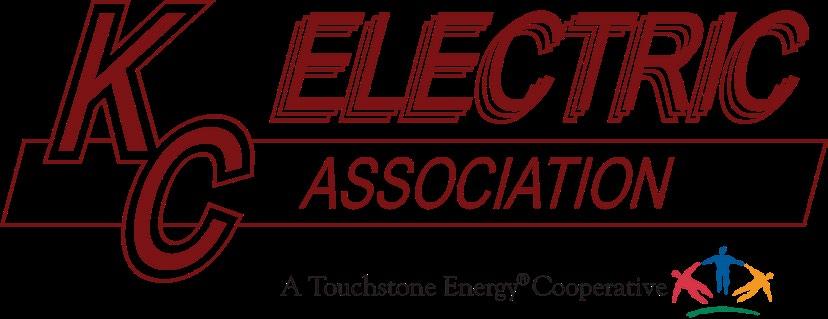
Our mission is to provide our members with safe, reliable service at the lowest cost, while maintaining an environmentally responsible, accountable, and sustainable operation now and in the future.
In a similar vein, we recognize that many members are considering electric vehicle options. K.C. Electric can provide information about EV charging and electrical requirements so you can make informed decisions about EVs. We can provide a candid assessment of residential and business charging requirements for all types of EVs.
K.C. Electric offers generous rebates on a wide range of outdoor power equipment such as electric lawn and riding mowers, electric snow blowers, chainsaws, trimmers, leaf blowers, and more.
So, the next time you hear us at K.C. Electric say “We’re here to serve you,” we hope you know that we mean it. Service is deeply ingrained in who we are. As we evolve with the changing times, we’ll continue to develop additional ways to serve you and provide more options to help power your life.
K.C. Electric Staff
David Churchwell General Manager dchurchwell@kcelectric.coop
Bo Randolph Office Manager and CFO brandolph@kcelectric.coop
Phone 719-743-2431 Toll-free 800-700-3123 Web kcelectric.coop
Darren Fox Operations Manager dfox@kcelectric.coop
George Ehlers
Member Services Specialist and IT Manager gehlers@kcelectric.coop
Address 422 3rd Avenue Hugo, CO 80821
K.C. ELECTRIC MISSION
Teen Driver Safety
Parenting teens can be challenging. While some battles aren’t worth fighting, protecting your teen behind the wheel of a vehicle is.
And although no one wants to think about teens being in motor vehicle accidents, it does happen. Protecting your teen behind the wheel is crucial due to their inexperience, which makes them more susceptible to crashes. Car accidents are a leading cause of death for teens in the United States, with the highest risk in the first year of driving. Common hazards include additional passengers, speeding, drowsy driving, and using phones.
Typically, more than 3,000 people die each year in crashes involving distracted drivers, including teens. Teen drivers often lack the skills and experience needed to avoid fatal crashes, and distractions such as texting can be particularly dangerous. For example, reading a text at 55 mph is like driving the length of a football field with your eyes closed. For this reason, Colorado has laws against texting, talking on the phone, and engaging in other distractions while driving.
There are three types of driving distractions to discuss with your teen:
• Visual, when you take your eyes off the road.
• Manual, when you take your hands off the wheel.
• Cognitive, when you take your mind off driving.
PREVENT DISTRACTED DRIVING
• Do not text while driving.
• Set your phone settings to block texts and keep your phone out of sight.
• Avoid eating while driving.
• Use playlists instead of searching for music.
• Set up navigation before driving or have a passenger navigate.
Teen drivers report pressure from families and friends to use phones while driving. Many drivers continue to use phones even when they are aware of the crash risk. Technology can help avoid cellphone use while driving. Use built-in features on your smartphone or cellphone blocking apps to prevent distractions. For the greatest safety benefit, change your phone settings to block calls and text messages while you're driving.
Visit SafeElectricity.org for more safety tips and consider downloading a Parent-Teen Driving Agreement from the Centers for Disease Control and Prevention.
4 SAFETY TIPS
TEEN DRIVERS NEED TO KNOW
1 THAT TEXT CAN WAIT
When texting while driving, the shortest amount of time a person takes his or her eyes o the road is ve seconds. At 55 mph, that is like driving the length of a football eld with your eyes closed.
2 don’t get out
If you are in a car accident involving a power line or padmount transformer (“green box”), stay inside the vehicle and call 9-1-1. Unless the car is on re or giving o smoke, do not get out. If there is a re, make a solid jump from the vehicle without touching it and hop with your feet together as far away as you can.
3 respect work zones Don’t Drive Distracted
One work zone crash occurs every 5.4 minutes. Remind teen drivers to consider anyone doing their job in or near the road as someone they know and love. Encourage them to move over and slow down for workers.
4
Texting is not the only form of distracted driving. Driving and doing anything else is multitasking. Eight deaths occur EVERY DAY due to drivers who drive distracted.
Learn more:

CLAIM YOUR SAVINGS
Each month, K.C. Electric members have a chance to claim a $20 credit on their next electric bill. All you must do is find your account number, call the Hugo office at 719-743-2431, and ask for your credit. The names and account numbers are listed below. How simple is that?
You must claim your credit during the month in which your name appears in the magazine (check the date on the front cover).
Ken Stroud, Hugo — 6411xxxxx
Hugh Scott, Flagler — 5341xxxxx
B J New, Flagler — 5135xxxxx
Victoria Mendoaz, Cheyenne Wells — 4310xxxxx
In June, three consumers called to claim their savings: Rod Thompson, Norbert Ohnmacht, and Stephen Notter.
ENERGY EFFICIENCY TIP OF THE MONTH
Replace your home cooling system’s filter regularly to maintain strong airflow and boost energy efficiency. A clean filter means your system doesn't have to work as hard, saving energy and lowering your utility bills. Factors like allergies and pets in the home can impact how often filters should be replaced. Check the filter every month and replace it as needed. Changing filters regularly also reduces wear and tear on your cooling system, helping extend the life of the unit.
Source: energy.gov
CREDIT CARD PAYMENT POLICY UPDATE
K.C. Electric Association’s credit card payment option will change for certain members beginning with the October 1 bill.
Members with electric services classified as small commercial, large commercial, oil well pumping, large power, street lighting, wind, and irrigation will no longer be eligible to make payments by credit card. These members must use cash, checks, electronic checks, or bank drafts.

K.C. Electric will continue to accept credit card payments from the following rate classes:
• Town residential
• Rural residential
• Non-domestic These changes will help the co-op:
• Reduce the amount of credit card processing fees K.C. Electric pays
• Minimize financial risk and administrative costs
• Ensure more efficient use of K.C. Electric’s resources
• Maintain service integrity across our membership
If you have questions about how this policy affects your account or if you need assistance with alternative payment methods, contact K.C. Electric’s Hugo office at 719-743-2431 or the Stratton office at 719-348-5318.
Thank you for your understanding and for your continued membership with K.C. Electric.

Smart Home Tech
Three savvy ways to save energy
Smart technologies make our homes more comfortable, convenient, and energy efficient. By connecting to your home Wi-Fi network, smart devices automate everyday tasks like lighting, heating, cooling, and home security — they can even communicate with other smart devices in the home.
While not all smart home products are specifically designed with energy savings in mind, there are several smart technologies that can help you lower home energy use. Here are the top three smart home devices to help you save.
SMART THERMOSTATS
Smart or not, your thermostat is the most effective tool for controlling energy use — heating and cooling typically account for the largest portion of energy bills. Smart thermostats allow you to adjust the indoor temperature through an app, giving you full control from anywhere on the go. Many smart thermostats also include learning capabilities and will adjust the temperature based on previous behavior and patterns.
According to the U.S. Department of Energy, smart thermostats can reduce heating and cooling bills by more than 8% annually. With models as low as $65, they typically pay for themselves in one year.
SMART LIGHTING
Smart LED bulbs use less electricity than traditional bulbs and can be scheduled and operated
remotely through a smart phone app. Smart bulbs are available in a range of shapes, brightness levels, colors, and more.
Many smart bulbs include motion sensors that turn on or off based on room activity, further optimizing home energy use. If you’re new to smart lighting, try a home starter kit. Prices for kits range from $70 to $300 or more, depending on how many bulbs you need.
SMART PLUGS
Smart plugs are inexpensive gadgets that can help you save energy. Many electronic devices consume power even when they are turned off — known as phantom load — which can take a toll on your energy bills. Smart plugs are simply plugged into an electrical outlet and connected to your Wi-Fi network. When set up, the smart plug can cut power to non-smart devices, like coffee makers, phone chargers, and other items that draw phantom load.
Many smart plugs can be paired with popular smart hubs, like Alexa or Google Nest, or controlled through the plug’s associated app. Smart plugs are simple to use and a set of four can be purchased for as little as $25.
If you’re looking for new ways to save energy, try these budget-friendly, convenient, smart home technologies.

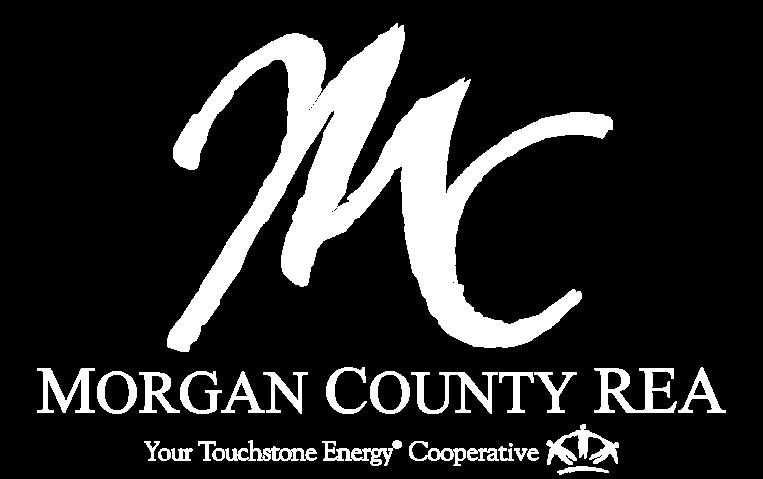
A Summer of Community
By Dave Frick General Manager
Summer always seems to go by in the blink of an eye, doesn’t it? It feels like we were just celebrating our graduating seniors and now it’s time for another school year to start. Summer goes fast and a lot has happened these past few months: picnics, parades, rodeos, concerts, and fairs. All of these events can be summarized in just a few words: Community. Celebration. Tradition.
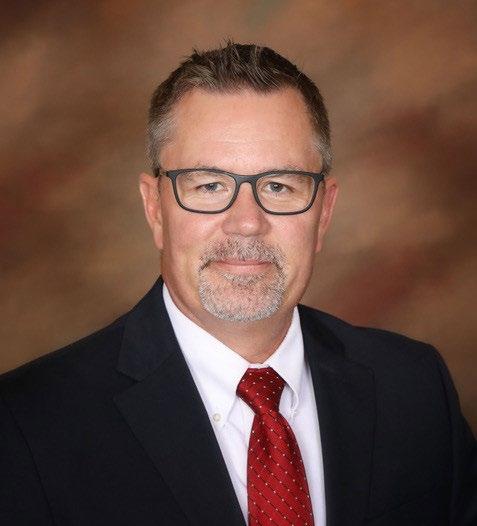
Community was on full display at Morgan County REA’s Member Appreciation Picnic in June, where over 300 people gathered at our headquarters to enjoy a meal, visit with neighbors, and celebrate the cooperative spirit.
July was an especially busy time in our service area, starting with Independence Day celebrations. Whether you watched the Fourth of July parade in Wiggins or Brush, took in the rodeo at the Morgan County Fairgrounds, or found a prime spot to watch fireworks throughout the county, there were plenty of opportunities to celebrate our great nation.
As soon as the final firecracker popped, anticipation for Bobstock quickly followed. Always held the second full weekend of July, Bobstock Music Festival is the largest free music festival in the region.
Thousands of locals and visitors flocked to downtown Fort Morgan for great music and fun.
MCREA, along with our partners at Tri-State Generation & Transmission and Basin Electric Power Cooperative, was proud to be a sponsor of the Brush Rodeo and Bobstock this year. Both are time-honored traditions and favorite community events.
Right after Bobstock, it was time to kick off fair season. Throughout our communities, 4-H and FFA members worked all summer getting their projects and animals ready. Regardless of the ribbons won, fair is a great time to celebrate their hard work. We also get the chance to catch up with our MCREA members, and we’re glad so many of you visited our fair booths the past few weeks. MCREA looks forward to participating in the Morgan County junior livestock sale each year as well.
As the summer draws to a close, we at MCREA thank you, our members, for supporting your electric co-op. This is a place we are proud to be part of, and we look forward to powering our community, celebrations, and traditions for many years to come.



2025 Youth Tour A week in Washington, D.C.
Each year, hundreds of students — selected by their local electric cooperatives — travel to Washington, D.C., for the Electric Cooperative Youth Tour. The idea for Youth Tour came from President Lyndon B. Johnson in 1957, when he was a still a United States senator.
Johnson suggested, “sending youngsters to the nation’s capital where they can actually see what the flag stands for and represents.” The idea evolved into an organized, fun, and educational trip in the 1960s. Since then, electric cooperatives from across the United States continue to send over 1,500 youth to Washington, D.C., every summer.
Carys Kudron, from Fort Morgan High School, was selected by Morgan County REA to attend this year’s tour. Throughout the weeklong adventure, Carys had a front row seat to both state and federal government, memorials, museums, and other special places.
“I met people from all over,” Carys recalled. “On the trip, we swapped state-themed pins with other students at Youth Tour. The pin I received from farthest away was from Rhode Island.”


The Colorado and Wyoming delegations traveled together on this year’s tour, where they visited sites such as Capitol Hill, Arlington Cemetery, Mount Vernon, and the National Cathedral — just to name a few. Carys enjoyed many of the stops, but a few really stood out.
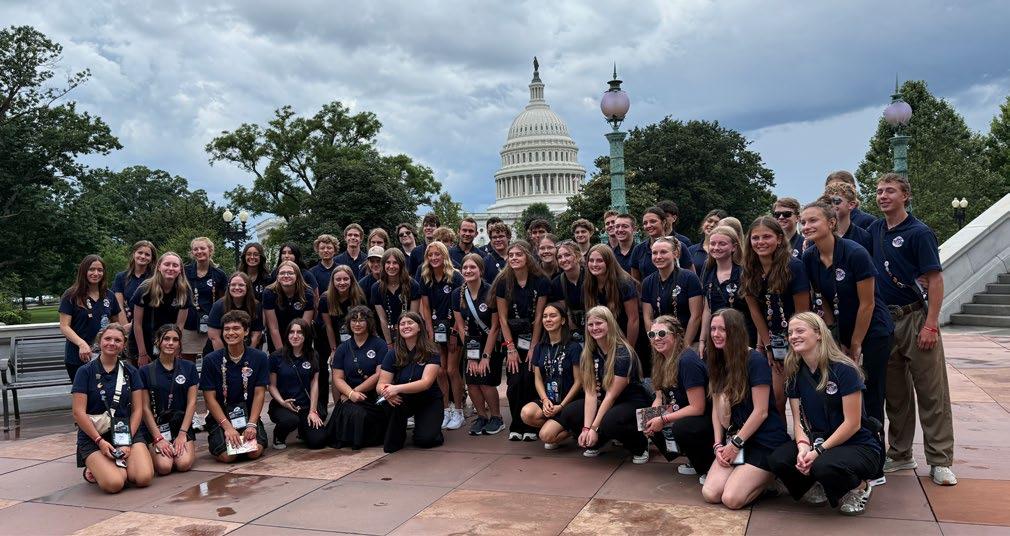
“The Library of Congress was fascinating and I learned so much. It has two copies of every book ever published, in addition to beautiful artwork and architecture,” Carys said. “The Smithsonian museums were also cool, especially the Museum of Natural History.”
The group visited many memorials, including the Vietnam Veterans Memorial, World War II Memorial, and Lincoln Memorial. “The Lincoln Memorial was my favorite,” Carys mentioned.
While Youth Tour is centered around our nation’s capital, it also aims to teach students more about electric cooperatives.
“A new thing I learned about electric co-ops is how much politics are involved,” Carys shared. “We learned how President Franklin D. Roosevelt played a role in starting electric cooperatives in the 1930s and how policy continues to impact them today.”
At this year’s Youth Tour, Carys gained a wealth of knowledge, new friends, and lifelong memories.
“One of my favorite parts of the trip was visiting the National Harbor on our final night in D.C., where I got to ride the Capital Wheel with my friends,” Carys says. “The whole trip was amazing.”
Each year, MCREA selects a student to attend Washington D.C. Youth Tour, an all-expense paid trip. Applications open in December and are open to students whose families are MCREA members.
To learn more about MCREA’s youth programs, visit mcrea.org/youth-programs.
The Colorado and Wyoming Youth Tour delegations visit Capitol Hill.
Carys (center) and other students visit the Lincoln Memorial.
Carys stands in front of the granite column recognizing Colorado, part of the World War II Memorial.
Planning a Project? Don’t Just Dig In.
August 11 is National Safe Digging Day and is an important reminder to always call 811 before you dig in to a project.
Whether it is a do-it-yourself endeavor or you are hiring a professional, always call 811 — a free locating service — two to three business days prior to starting any digging project to request that all underground utilities be marked.
You may think it won’t hurt anything to dig in an unmarked yard when landscaping, installing a fence, deck, or mailbox, or even “just” planting a small flower bed or bush. However, damaging an underground cable can have serious consequences.

Digging into a line could result in serious injuries and disrupted service for you and your neighbors. It could also make a dent in your wallet for repair fees or other fines.
The 811 hotline points out that there is more than one football field’s length of buried utilities for every man, woman, and child in the United States. (Mark Strickland, acct. #xxx5400)
Remember that privately owned underground lines will NOT be marked by location flaggers. Examples of private lines and equipment include well and septic, underground sprinkler systems, invisible fencing, gas or electric lines that serve a detached building, as well as any electric, water, or sewer lines from the meter to your home. If you have any private utilities, you will need to hire a private utility locator.
Win a $25 Bill Credit!
STEPS TO SAFE DIGGING
1. Call 811 or visit colorado811.org to submit a request two to three business days before work begins.
2. Wait the required amount of time for utility operators to respond to your request.
3. Confirm that all utility operators have responded to your request and have marked underground utilities.
4. Dig carefully around the marks with care.
Each month, Morgan County REA gives two lucky members a chance at a $25 bill credit, just by reading Colorado Country Life. Congratulations, Joseph DeCarlo! You spotted your name in the June magazine and claimed your credit.
There are two more member names and their account numbers hidden somewhere in this issue. If you find your name and account number call MCREA’s communications department at 970-8675688 by August 29 to claim a $25 credit on your next bill.
Smart Home Technology
Three ways to save energy
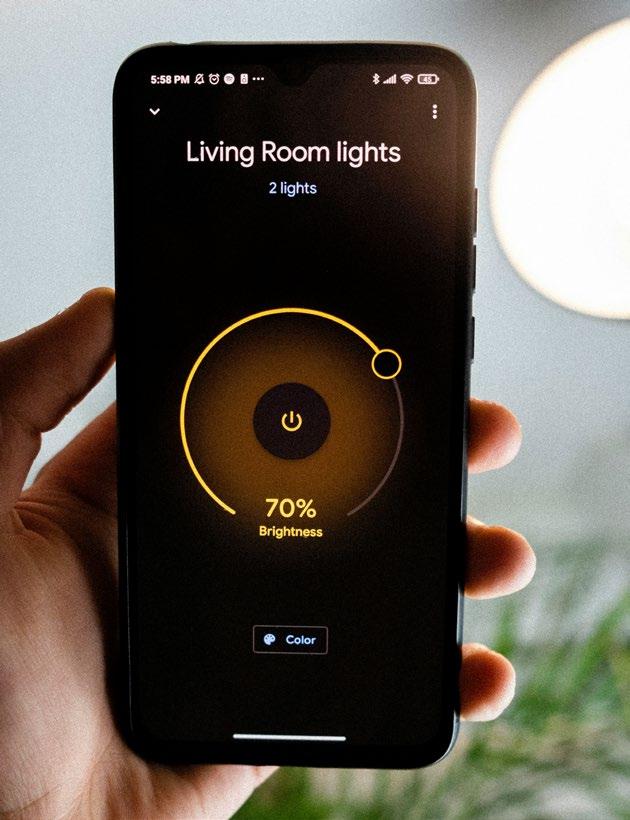
Smart technologies make our homes more comfortable, convenient, and energy efficient. By connecting to your home Wi-Fi network, smart devices automate everyday tasks like lighting, heating, cooling, and home security — they can even communicate with other smart devices in the home. (Rick Brown, acct. #xxx9200) While not all smart home products are specifically designed with energy savings in mind, there are several smart devices that can help you lower home energy use. Here are three smart home devices to help you save.
SMART THERMOSTATS
Smart or not, your thermostat is the most effective tool for controlling energy use — heating and cooling typically account for the largest portion of energy bills. Smart thermostats allow you to adjust the indoor temperature through an app, giving you full control from anywhere on the go. Many smart thermostats also include learning capabilities and will adjust the thermostat based on previous behavior and patterns.
According to the U.S. Department of Energy, smart thermostats can reduce heating and cooling bills by more than 8% annually. With some models costing as low as $65, they typically pay for themselves in
one year. Another perk — Morgan County REA offers rebates for qualifying smart thermostats.
SMART LIGHTING
Smart LED bulbs use less electricity than traditional bulbs and can be scheduled and operated remotely through a smartphone app. Smart bulbs are available in a range of shapes, brightness levels, colors, and more.
Many smart bulbs include motion sensors that turn on or off based on room activity, further optimizing home energy use. If you’re new to smart lighting, try a home starter kit. Prices for kits range from $70 to $300 or more, depending on how many bulbs you need.
SMART PLUGS
Smart plugs are inexpensive gadgets that can help you save energy. Many electronic devices consume power even when they are turned off — known as phantom load — which can take a toll on your energy bills. Smart plugs are simply plugged into an electrical outlet and connected to your Wi-Fi network. When set up, the smart plug can cut power to non-smart devices, like coffee makers, phone chargers, and other items that draw phantom load.
Many smart plugs can be paired with popular smart hubs, like Alexa or Google Nest, or controlled through the plug’s associated app. Smart plugs are simple to use and a set of four can be purchased for as little as $25.
If you’re looking for new ways to save energy, try these budget-friendly, convenient, smart home technologies.
ENERGY EFFICIENCY
TIP OF THE MONTH
Replace your cooling system’s filter regularly to maintain strong airflow and boost energy efficiency. A clean filter means your system doesn’t have to work as hard, saving energy and lowering your utility bills. Factors like allergies and pets in the home can impact how often filters should be replaced. Check the filter every month and replace it as needed. Changing filters regularly also reduces wear and tear on your cooling system, helping extend the life of the unit.

ROOTED IN RELIABILITY
MVEA’s Commitment to Wildfire Mitigation
By Ruth Marks CEO
Mountain View Electric Association’s mission is vital: to deliver safe, reliable, affordable, and responsible electricity to you — our members. That mission has never been more important as we face increasing wildfire risk across Colorado. Our state’s growing population, increasingly dry conditions, and suburban spread into wildland-urban areas has changed the conversation about, and the urgency for, proactive utility wildfire mitigation planning. Let’s take a look at MVEA’s efforts to reduce wildfire risk through strategic planning and system upgrades.
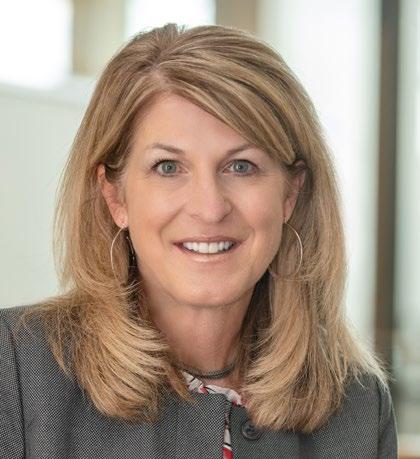
round program to trim trees and remove vegetation around our lines, poles, and equipment. These efforts reduce wildfire risk and improve the reliability of your electric service by minimizing outages caused by branches or trees.
MVEA’s wildfire mitigation plan is comprehensive. It starts with maintaining and improving the electric system itself. We regularly patrol, inspect, and upgrade our infrastructure to ensure it meets or exceeds industry standards for safety and performance. This includes investing in system hardening, such as replacing poles and equipment with fire-resistant materials and installing devices that limit sparks and faults.
We are expanding our efforts on the ground by having eyes in the sky. Our drone inspection program allows us to safely and efficiently inspect hard-to-reach areas of our system, identify potential risks earlier, and to act before problems arise. This technology allows us to assess fire risk, prioritize projects, and allocate resources where they are needed most.
Vegetation management remains a critical part of our approach. Trees and vegetation growing too close to power lines can create fire hazards. We have a year-
PROTECTING
We are also harnessing the power of cutting-edge technologies. We are currently building a new Advanced Distribution Management System (ADMS) with Supervisory Control and Data Acquisition (SCADA) technologies that will give us better situational awareness, improve operational efficiency, and reduce outage response times. These tools are cornerstones of our evolving smart grid strategy, helping us deliver even greater reliability and prepare for an increasingly dynamic energy landscape — all while enhancing our ability to monitor and respond to wildfire risks in real time.
To help offset the cost of our wildfire mitigation strategy and system upgrades, last year MVEA was awarded $771,000 from the U.S. Department of Energy. These funds are being used to enhance the resiliency of our infrastructure and improve fault detection to ensure high reliability during extreme weather events.
As we look ahead, please know that MVEA remains vigilant and proactive in addressing wildfire risks. Everything we do is rooted in reliability and our promise to follow through on the commitments we make to our members. For more details about our wildfire mitigation plan and for tips to reduce wildfire risk on your property, visit www.mvea.coop/wildfire-mitigation
OUR COMMUNITY & RELIABLE POWER SUPPLY
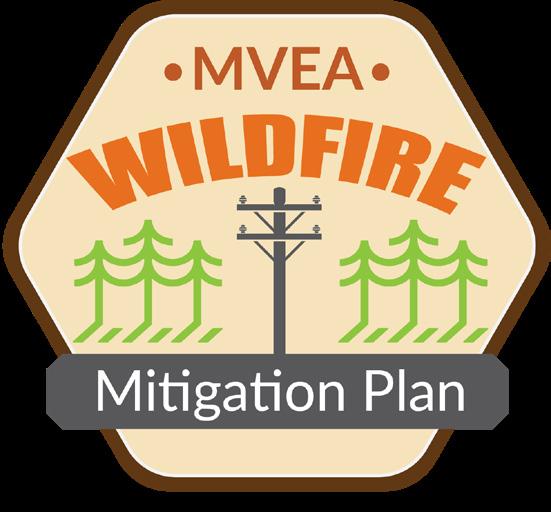

Mountain View Electric Association is committed to keeping people, their belongings, and properties safe from wildfires. Learn how our comprehensive plan can help us reduce the risk of wildfires in the communities we serve and about MVEA’s participation in the Wildfire Assessment and Resilience for Networks project (WARN). Visit our webpage dedicated to wildfire safety, where you’ll find helpful information and resources about the following topics:
• Vegetation Management
• Operational Practices
• Advancing MVEA’s Initiatives
• Working with MVEA Members
• Wildfire Preparedness
Errol Hertneky and his wife, Bette, have been side by side through 57 years of marriage – and throughout Errol’s 12 years of service on the MVEA Board. Bette was a constant supporter, attending most events with him.
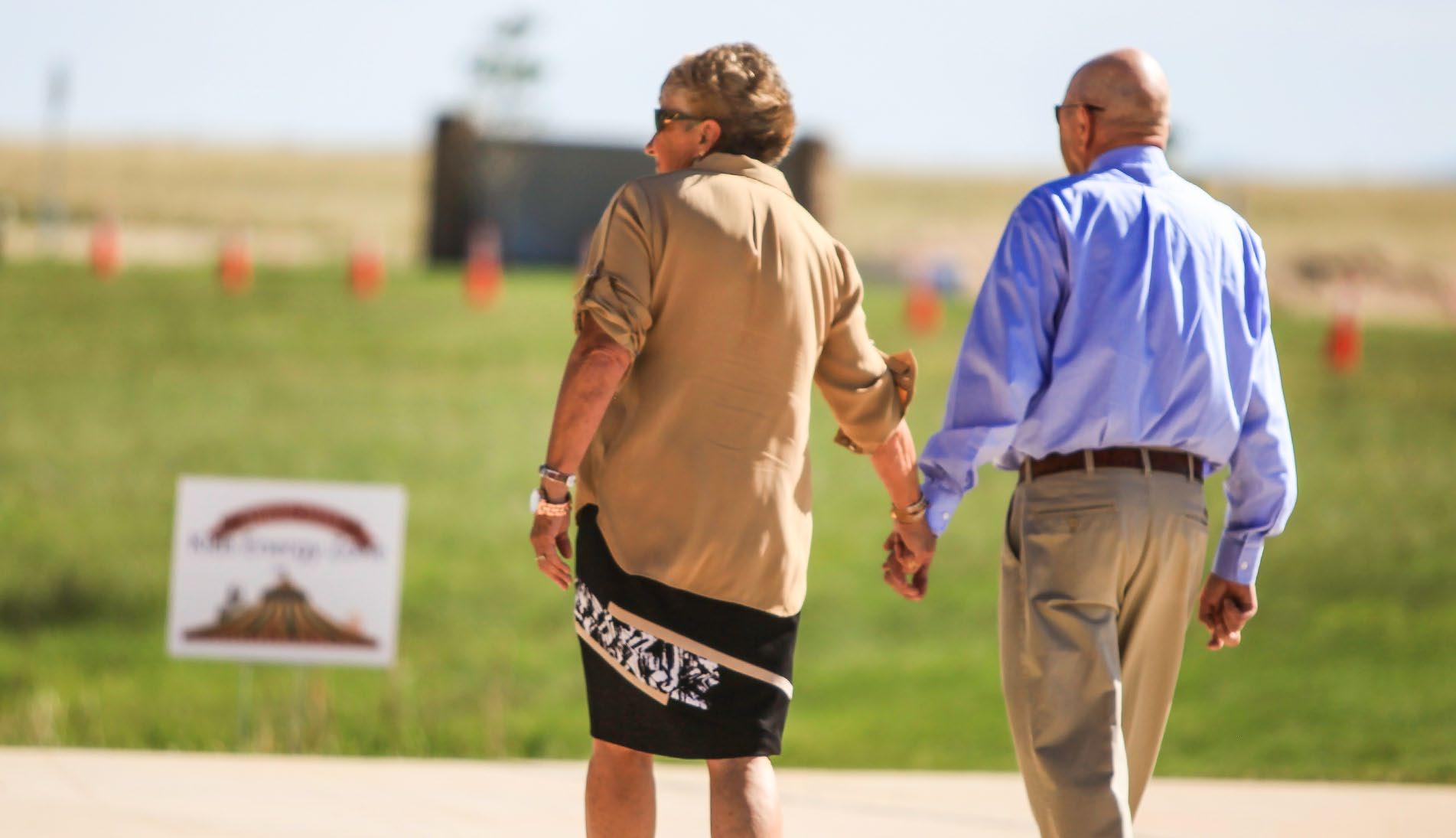
From Power Poles to Fiber Lines
Honoring Errol Hertneky’s 12 years of MVEA Board service
By Erica Meyer Community Relations Specialist
When Errol Hertneky recalls his earliest memory of Mountain View Electric Association, he sees a wooden power pole standing tall on his family’s Calhan farm. “I was four or five when our first pole went in,” he said. “I remember staring at it before the lines were finally strung and the lights came on.” That pole marked the beginning of a lifelong connection to the cooperative his father helped found.
With a family rooted in the co-op’s origins, Hertneky’s decision to join the MVEA Board in June 2013 felt natural. “It seemed like a good challenge,” he said. “When I found out the director in my district was retiring, I went for it.” After college and six years serving in the Colorado National Guard, he returned to the farm and eventually opened an accounting firm. His background made him a steady, thoughtful voice on the Board for 12 years.
“The biggest change I’ve seen is MVEA’s shift from a rural co-op to one serving rapidly growing areas like Falcon and Monument,” he said. As the membership grew, so did the challenges. Hertneky helped guide MVEA through this transformation while keeping reliability and affordability front and center.
Hertneky’s proudest contribution? Helping bring fiber broadband to MVEA members through partnering company Conexon Connect. “That will have the biggest impact,” he said. “I’ll be happy when all
members have access.” His focus on future-proofing the co-op reflects his belief in long-term value for rural and urban members alike.
In 2021, Hertneky earned the National Rural Electric Cooperative Association Director Gold Credential, a national recognition he’s especially proud of. He and his wife, Bette — married 57 years — attended many trainings and conferences together. “Bette was a big part of my time on the Board,” he said.
Though he’s stepping away from the Board, Hertneky is far from slowing down. He still runs his accounting firm from home, tends cattle, and restores old vehicles. He also hopes to take up scuba diving again — a passion that’s taken him to seven countries. He and Bette enjoy time with their kids, Dana and Travis, grandkids Tayler and Trent, dog Penny, cat Flowers, and their cows.
Hertneky’s legacy is written in every mile of line and every member he’s served. His steady leadership has helped power MVEA’s past — and illuminate its future. “Members are MVEA’s story,” he said. “When your lights go out, mine go out. When your rates rise, so do mine. We’re all one.”
MVEA will greatly miss Errol Hertneky’s insight, dedication, and steady leadership — and we extend our deepest thanks for his 12 years of faithful service to our members and our mission.



Quarterly “Switch & Save” $300 Account Credit Winner Spotlight: Shayla McCullough
Shayla McCullough, a resident of Karval, was excited to get the call that an account credit was headed her way. “Electric bills can be daunting, especially in the summer when you’re running air conditioning 24/7 most days...This program is a beautiful blessing and I couldn’t be happier,” she shared.
Do you want a chance to win a $300 account credit? Go paperless through SmartHub, or bank account auto-pay, and save up to $1 per month!
All participating “Switch & Save” accounts are automatically entered into the quarterly drawing!
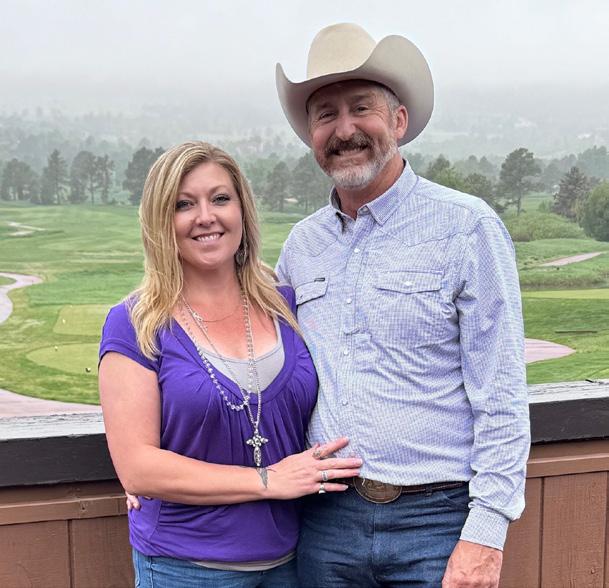

BOARD OF DIRECTORS
Kevin L. Paddock, District 5 President
Barry R. Springer, District 6 Vice President
Jim Riggins, District 7 Secretary-Treasurer
Joseph D. Martin, District 1 Assistant Secretary
Rick L. Gordon, District 2
Wayne Vanderschuere, District 3
Open Seat, District 4
(800) 388-9881 (719) 495-2283
Website www.mvea.coop
Falcon Office 11140 E. Woodmen Road Falcon, CO 80831
Limon Office
1655 5th Street • P.O. Box 1600 Limon, CO 80828
Office Hours
Monday - Thursday 7 a.m. to 5:30 p.m.
Stay Connected: Like. Follow. Share.
Make sure to connect with MVEA on social media for timely service and program updates.
www.facebook.com/@MVEAInc
www.linkedin.com/company/ mveainc
www.x.com/@MVEAInc
www.youtube.com/@MVEAInc

www.instagram.com/MVEAInc
To provide our members safe, reliable, affordable, and responsible electric service and access to broadband services.
This Association is an equal opportunity provider and employer.
An MVEA member since 2014, Shayla and her family reside in Karval.
Beat The Peak & Save All Year
Is MVEA’s Time-of-Day Rate Right for You?
MVEA’s Time-of-Day Rate offers a cost-saving incentive to members who shift their electric use to off-peak, lower rate periods to reduce the co-op’s overall demand and power cost. For instance, while MVEA’s current regular residential rate is $0.113 per kilowatt-hour (kWh), members on the TOD rate pay only $0.075 per kWh between the hours of 9 p.m. and 5 p.m. but pay $0.29 per kWh during the evening peak hours of 5 p.m. to 9 p.m.
Can you shift your electric use away from MVEA’s evening peak hours of 5 p.m. to 9 p.m. to save energy and money all year long? It’s worth a visit to www.mvea.coop/rates or a call to (800) 388-9881 to find out if this rate is right for you!
The High Demand Energy User
Using several appliances at once creates a higher demand for electricity.
On-Bill Repayment Program (OBR)
Take advantage of the On-Bill Repayment program for a simple and transparent low-interest financing option for energy efficiency upgrades. No money down. No credit check.
+ Windows & Doors + Insulation
+ Whole-home or Attic Fans + EV Chargers
+ Electric HVAC Systems + And More!
www.mvea.coop/electrify-and-save
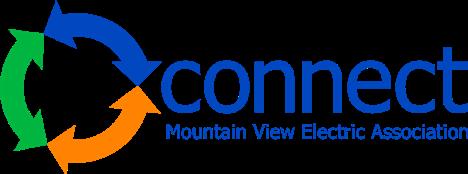


The Energy Conserver Spreading electric use out throughout the day helps beat the peak and conserve energy!
PROGRAMS TO SAVE ENERGY & MONEY
Energy Efficiency Rebate Program
From select appliances to heat pumps, and electric mowers to EV charging equipment, there is a rebate to fit the need of nearly every member who wants to save energy and money.
+ Smart Thermostats + Electric Heat Pumps
+ Select Appliances + EV Chargers
+ Electric Bicycles + And More!
www.mvea.coop/rebates



MVEA PEAK
MVEA PEAK DEMAND
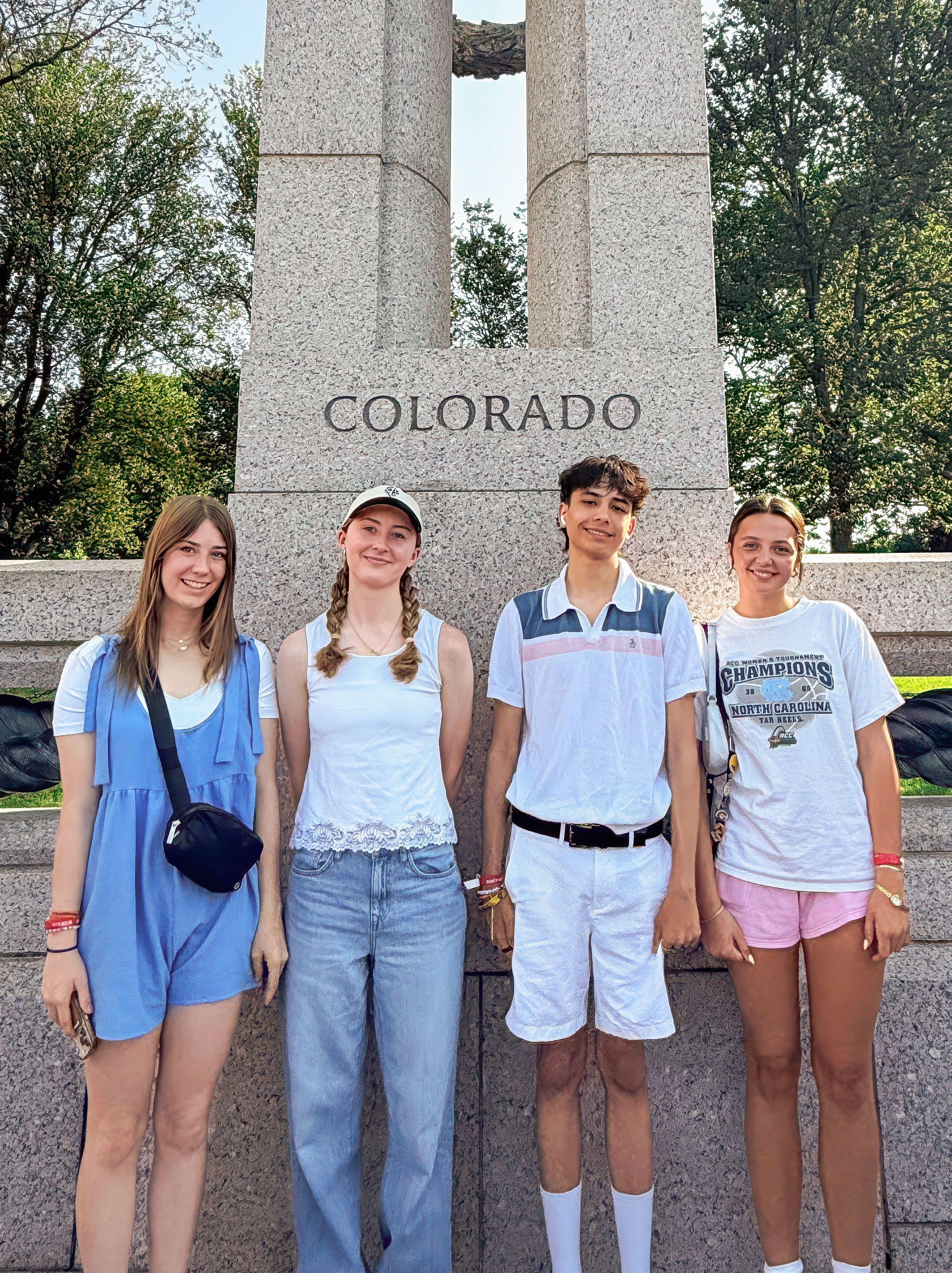

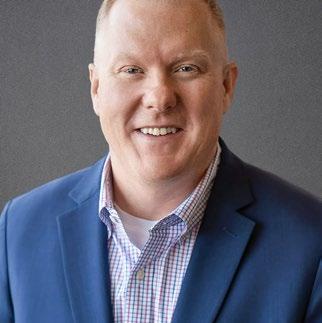
Power You Can Count On: Today & Tomorrow
BY JEFF WADSWORTH PRESIDENT & CEO
When you flip a switch, you expect the lights to come on. That simple expectation guides everything we do, and we take that responsibility seriously.
Poudre Valley REA is dedicated to managing and maintaining a strong, resilient electric grid so your power is there when and how you need it.
To do so is a team effort led by us, your local electric provider, as well as our power supplier, Tri-State, and other regional partners. Each has a role to play in the complex network of power lines and equipment that delivers electricity from its source to your home or business.
Our wholesale power provider first generates power for the bulk electric grid and then transmits it over long distances across highvoltage transmission lines, which regional utility partners maintain. From there, the electricity reaches our local distribution system, enabling us to deliver it directly to you.
regional partners to strengthen the entire system, so you can continually count on reliable, resilient service.
Our overall reliability metrics remain among the best in the nation. We rank in the top quartile for electric service reliability, thanks to our ongoing investments in upgraded infrastructure, advanced monitoring, and smart grid technology.
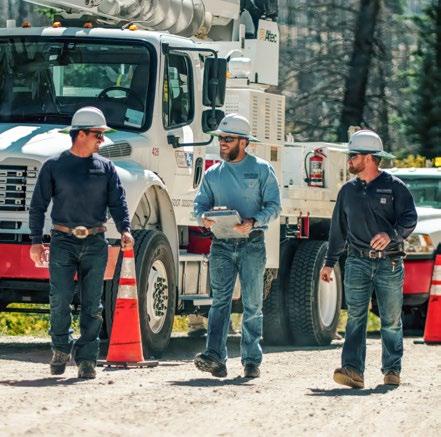
Combined with the strong relationships we’ve built with our power supplier and regional partners, these efforts mean fewer outages, faster response times, and a more resilient system for you.
A failure in the larger bulk electric grid can trigger a widespread outage that impacts many more members than a typical distribution problem, as seen last month when downed transmission poles led to an outage for many of our members. In comparison, issues on our local system are usually weather-related and affect smaller pockets of homes and businesses.
But we’re not here to pass the buck. We know that if the power goes out, the cause doesn’t matter to you. It’s an inconvenience, plain and simple.
That’s why we’re committed to working closely with our power supplier and
Reliability is at the heart of everything we do. As a cooperative member, you have Poudre Valley REA and our cooperative power provider working for you.
That’s the cooperative difference. We face challenges together. We find solutions together. And we power the future — together!
ABOUT YOUR CO-OP
PVREA serves energy solutions to more than 57,000 homes and businesses in Boulder, Larimer, and Weld counties. We are a memberowned co-op, led by those we serve.
OUR MISSION
We are committed to providing safe, reliable, efficient energy solutions with exceptional service to our members.
CONTACT US
1.800.432.1012 pvrea@pvrea.coop www.pvrea.coop
MAILING ADDRESS
Poudre Valley REA
7649 REA Parkway
Fort Collins, CO 80528
SOCIAL facebook.com/PoudreValleyREA instagram.com/poudre_valley_rea youtube.com/PoudreValleyREA
BOARD OF DIRECTORS
Chair
Peter Hyland
Weld County
Vice Chair
Bryan Ehrlich
Larimer County
Secretary
Thaine Michie
Larimer County
Director
Steven Anderson
Larimer
Director
Sheryl Dryer
Larimer County
Jack Schneider
Weld
Boulder County
National Outage Durations in Minutes
Source: IEEE Benchmark Year 2024 Study Colorado Country Life
BACK TO SCHOOL ISSUE
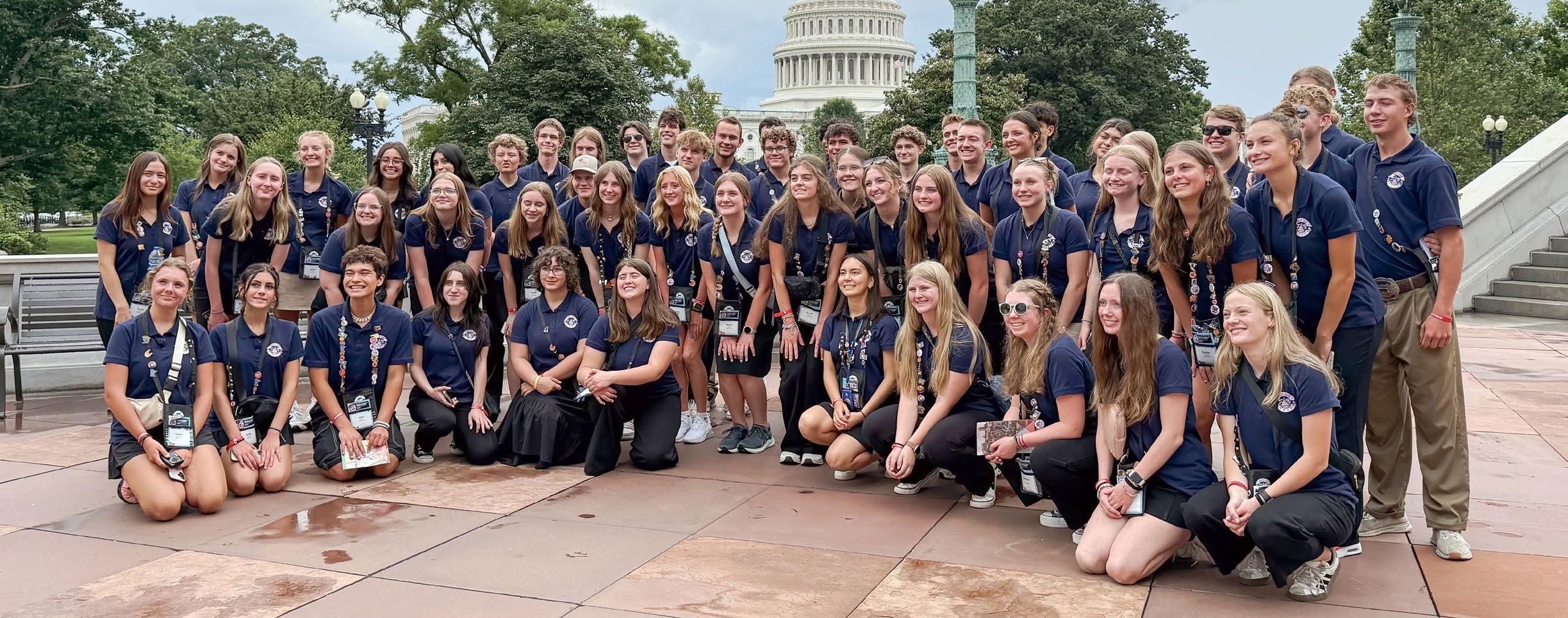
HISTORIC ADVENTURES
Your Kids In D.C.
Exploring the U.S. Capitol and the Library of Congress; meeting with legislative leaders from Colorado; visiting museums and memorials; and making memories that will last a lifetime while learning about the cooperative difference — meet this year’s Washington, D.C. Youth Tour Representatives!

AUDRA DIDIER
What experience stands out in your mind the most?
“The entire experience as a whole was amazing. What stands out the most to me was the opportunity to make so many new connections with people from all over. I made friends with kids from so many different states and made connections with many important adults in legislation.”

TRAYSON GOOD GUN
How did you feel about the trip overall?
“The motto of a trip of a lifetime wasn’t a lie at all, and getting to come on the trip allowed me to experience a trip in a way that I would have never gotten to. For that, I am sincerely thankful.”

REECE YAHN
What was your favorite landmark you visited?
“My favorite landmark was the Library of Congress! I loved the architecture and all the stories that the paintings and sculptures told! We looked at Thomas Jefferson’s book collection and the history behind how his collection became a part of the Library of Congress was really interesting.”

MAKENNA KROELLS
What was it like meeting legislative staff?
“Meeting legislative staff was so much fun! We had conversations about what they do for their work and how they got interested in their position. I also learned more about the legal aspects that go into running electrical cooperatives.”
Experience Washington, D.C.
Electric Cooperative Youth Tour \\ APPLICATIONS OPEN AUG 18
Students travel to Washington, D.C., visiting state and national monuments while engaging with elected officials along their way! They’ll learn about our great nation and meet students from across the country.
Who’s it for? High school juniors and seniors
When is it? Mid-June, 2026

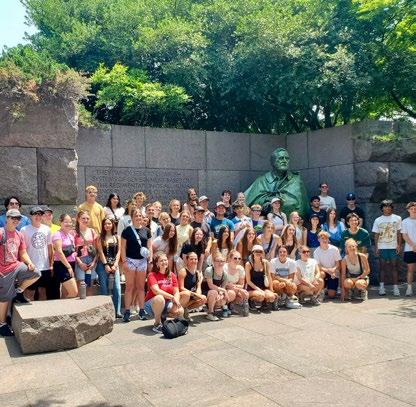
Where is it? Denver and Washington, D.C.
What’s the cost? This trip is free to attend! Scan the code to apply
Access Funding for Your Classroom
Teachers can apply for up to $2,000 in grants to support their K-12 classrooms’ STEAM projects.
• Who Can Apply? Teachers and administrators in Larimer, Weld, and Boulder County
• Projects Supported: Science, Technology, Engineering, Arts, & Math
• Individual Grant Amounts: Up to $2,000
Kids Corner
• Total Program Budget Available: Up to $25,000

• Application Schedule: Applications are accepted between June to November each year, with winners notified in December.
Scan the code to apply
Here’s your one-stop-shop for camps, trips, scholarships, educational grant opportunities, safety demonstrations, and more!
Find all the resources for our youngest members. Scan the code or go to www.pvrea.coop/my-community/for-our-kids/

Developing the Leaders of Tomorrow
Cooperative Youth Leadership Camp
This weeklong summer camp brings young people together from Colorado, Kansas, Oklahoma, and Wyoming to build leadership skills, learn about electric cooperatives, and make lasting friendships.
Scan the code to apply
APPLICATIONS OPEN AUG 18
• Who’s it for? High school juniors and seniors
• When is it? Mid-July, 2026

• Where is it? Glen Eden Resort near Steamboat Springs, CO
• What’s the cost? This trip is free to attend!
SAFETY CORNER
What Are Those Green Boxes?

A green padmount transformer is a metal box that sits on the ground and helps deliver electricity safely to homes and businesses.
You’ll often see them in neighborhoods, near sidewalks, or in yards, especially where power lines are buried underground.
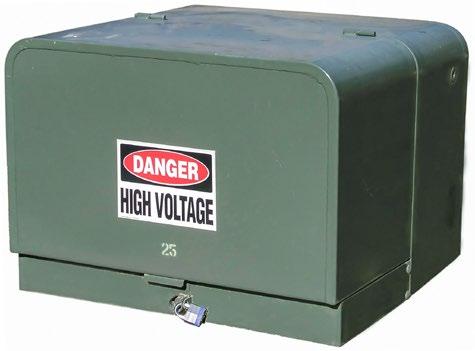
PADMOUNT TRANSFORMER SAFETY TIPS
• Keep plants, fences, pets, and children away from green transformer boxes.
• Utility crews need at least 10 feet on all sides to work safely and access electrical components during outages and scheduled maintenance.
• Keep a clear path to the transformer — even if it’s in your yard. It’s technically on an easement, and we require access to these electrical devices.
Find additional electrical safety resources online at www.pvrea.coop
Scan to learn more
Community Education Services \\
We provide FREE electrical safety demonstrations as a service to our communities. Two options are available depending on age and size of the event – the Power Town tabletop demonstration and the High Voltage demonstration built on a full-sized trailer.
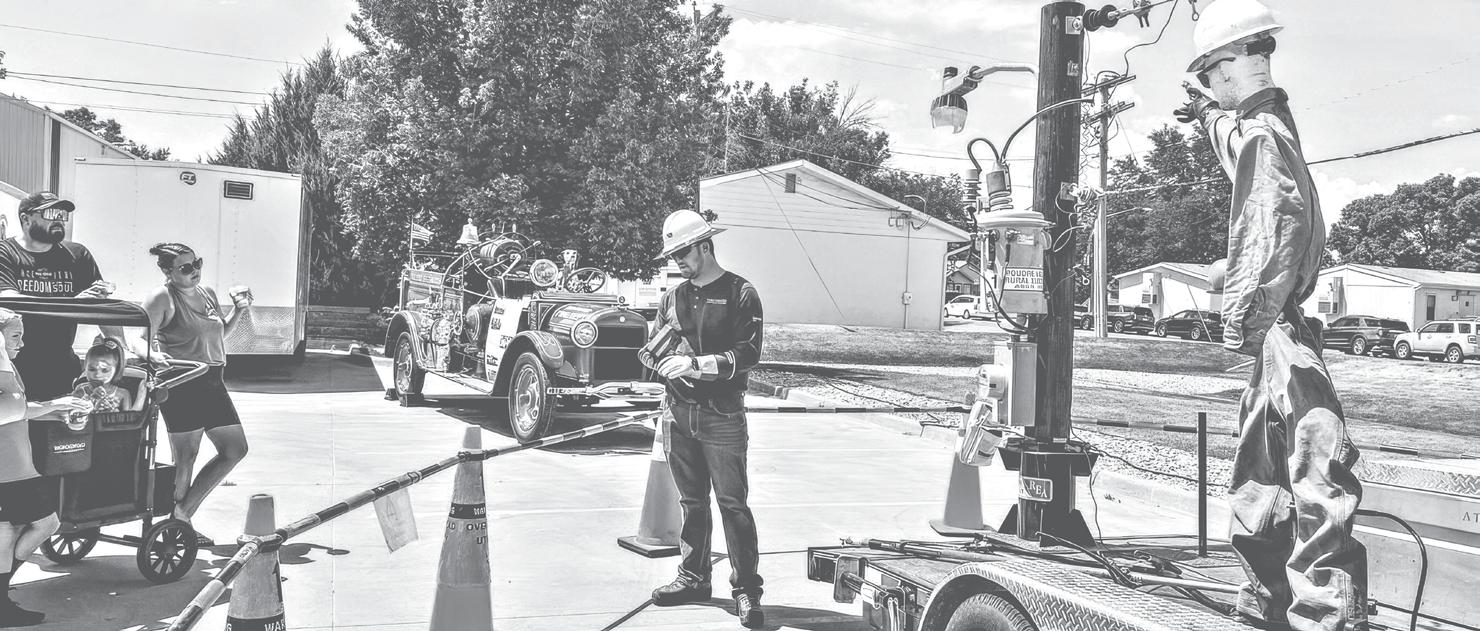
ELECTRICAL SAFETY DEMONSTRATIONS
If interested in a safety demonstration for your classroom, school, or group, submit your request online.
Scan to Reserve Your Demo
Our Youth are Our Future
Continuing Education Scholarships \\ APPLICATIONS OPEN AUG 18
Your cooperative helps our students pay for their education, so they can go on and create a brighter tomorrow. Each year, we award over $50,000, funded by unclaimed member credits.
• Who Can Apply? High school seniors
• Scholarship Amounts: $500 to $2,000

• Number of Scholarships Available: 29
• Application Scoring: Based on academics, well-roundedness, and financial need
Scan the code to apply

August brings some of the most extreme summer temps, which means people spend more time indoors avoiding the heat, and air conditioners work overtime.
This increased use of electricity causes spikes in demand, also known as “energy peaks”. During peak times, we work closely with our cooperative wholesale power provider to ensure a balanced, reliable, and safe supply of electricity is always available to meet our community’s energy needs.
You can help ease electricity demand by conserving energy. It’s easy — just check the clock and avoid energyintensive activities during peak energy-use hours.
When we all work together, everyone in our membership saves. Conserving energy during peak times eases pressure on the grid and helps balance the supply and demand of electricity.
SAVE ENERGY (AND MONEY)
DURING THE SUMMER PEAK
• Set your thermostat a few degrees higher. Enroll in Power Peak Rewards for annual bill credits for your participation in demand management.
• Use ceiling fans to feel up to 4 degrees cooler. Operate ceiling or oscillating fans in occupied rooms to supplement your AC.
• Plan energy-intensive activities like laundry and running the dishwasher for off-peak hours. Use automatic timers to run hot tubs, pool pumps, tank heaters and other appliances in the same way.
• Unplug appliances when they’re not in use or use power strips to manage devices.
• Close drapes and blinds during the afternoon to block unnecessary heat from sunlight.
Learn more about Power Peak Rewards at www.pvrea.coop/power-peak-rewards
Read more energy efficiency tips and tricks online at www.pvrea.coop

AUGUST 2025
Energy Efficiency Tip of the Month
Replace your cooling system’s filter regularly to maintain strong airflow and boost energy efficiency. Check the filter every month and replace it as needed.
A clean filter means your system doesn’t have to work as hard, saving energy and lowering your utility bills.
Changing filters regularly also reduces wear and tear on your cooling system, helping extend the life of the unit.
TIPS TO BEAT THE SUMMER PEAK

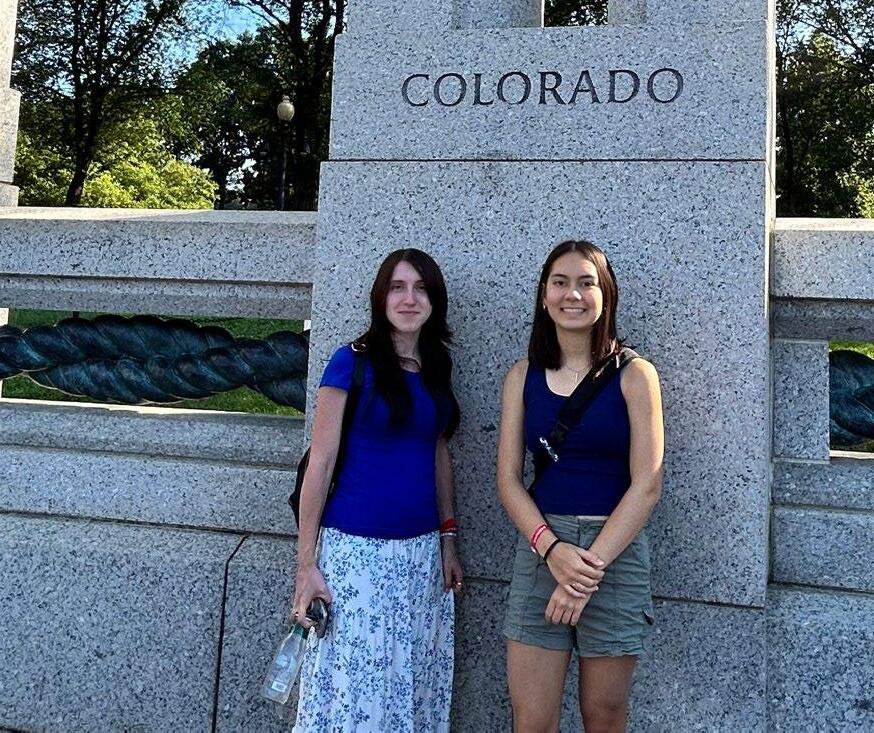
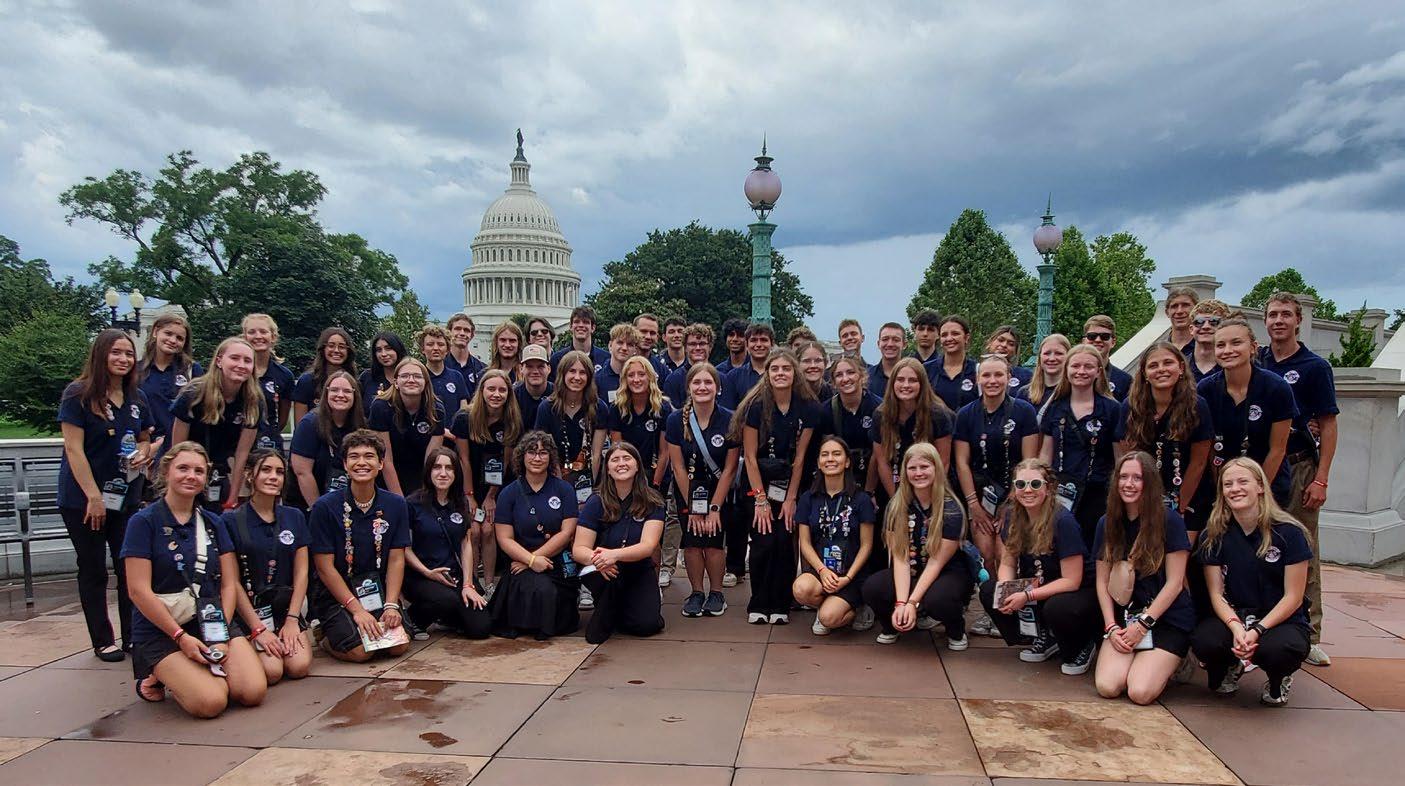
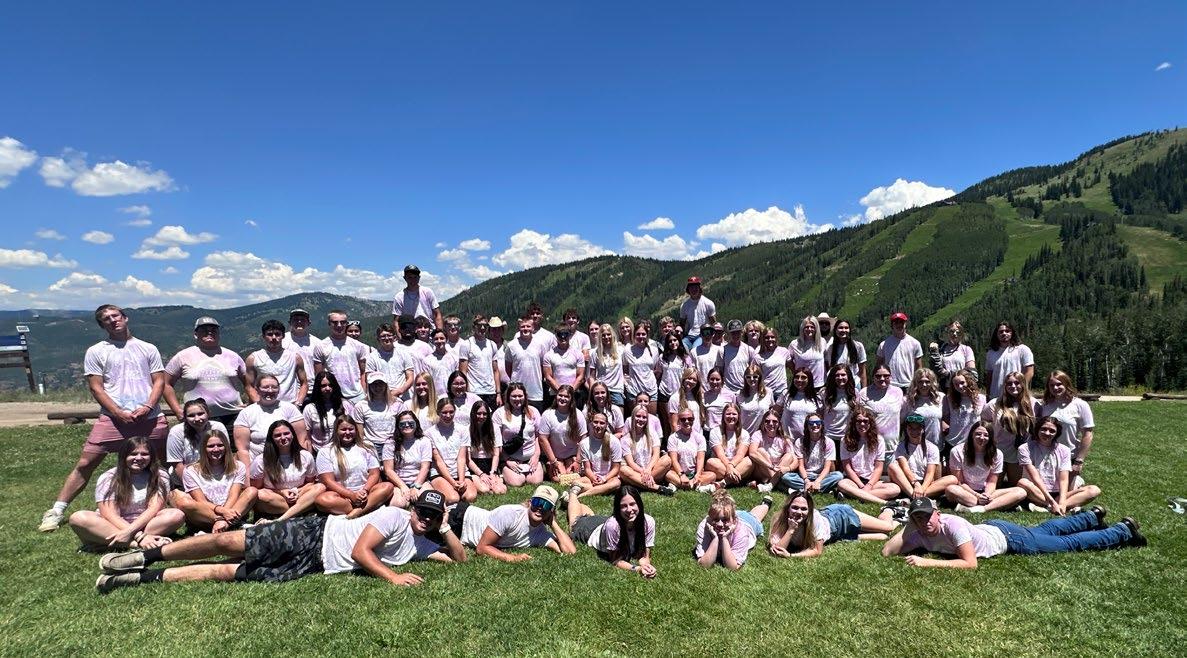
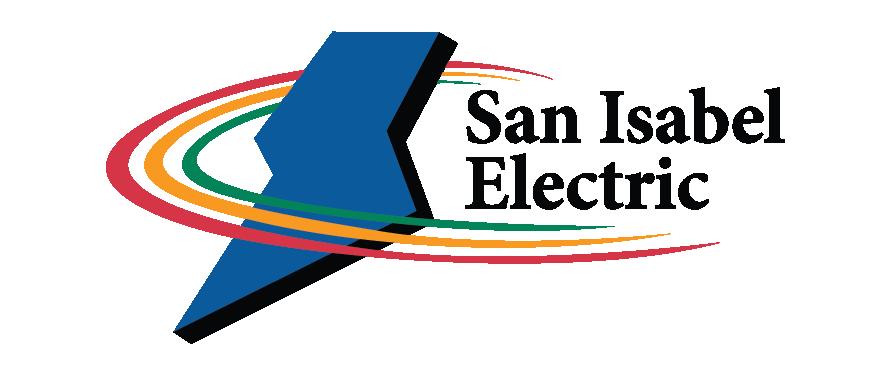

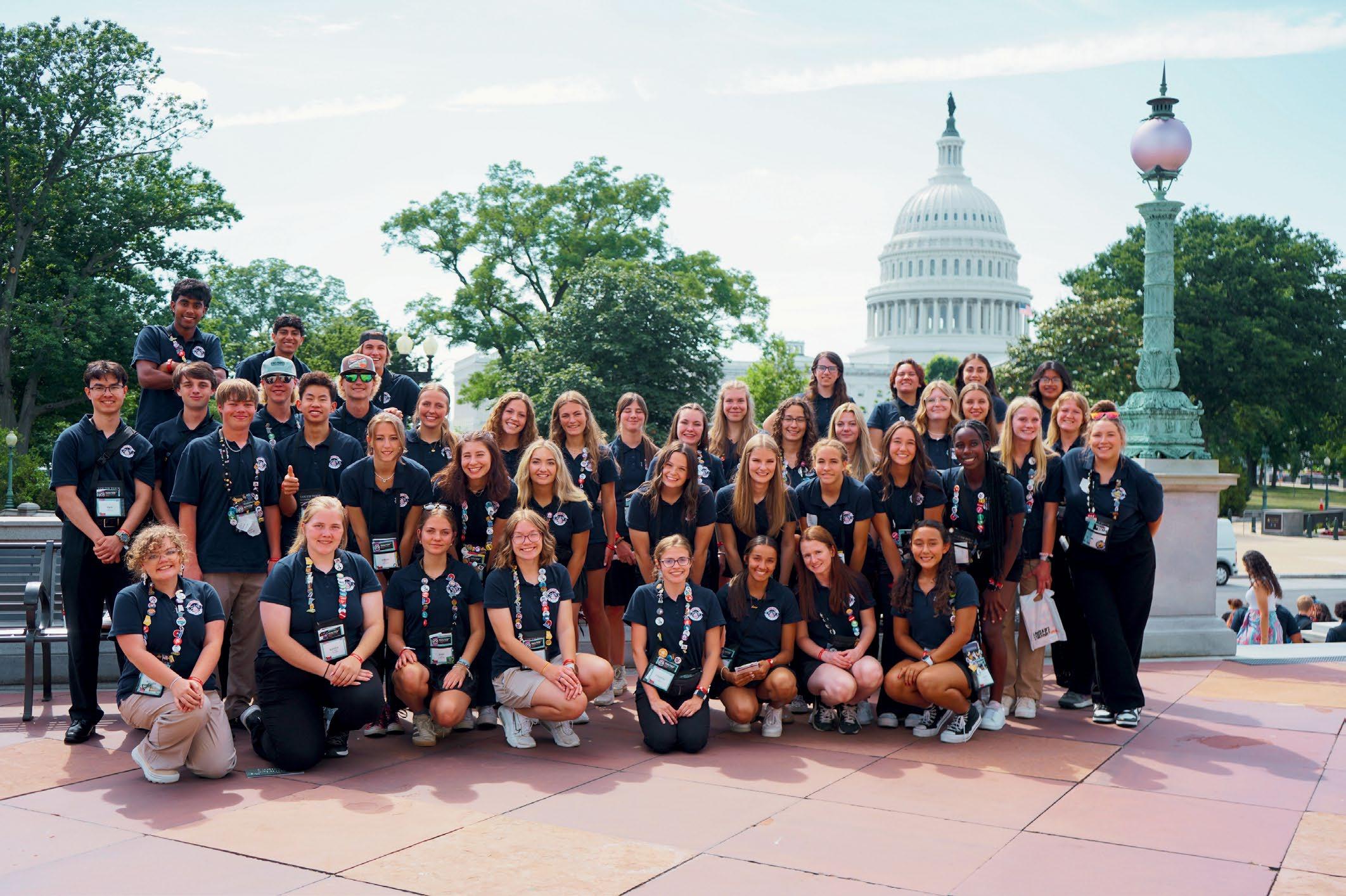

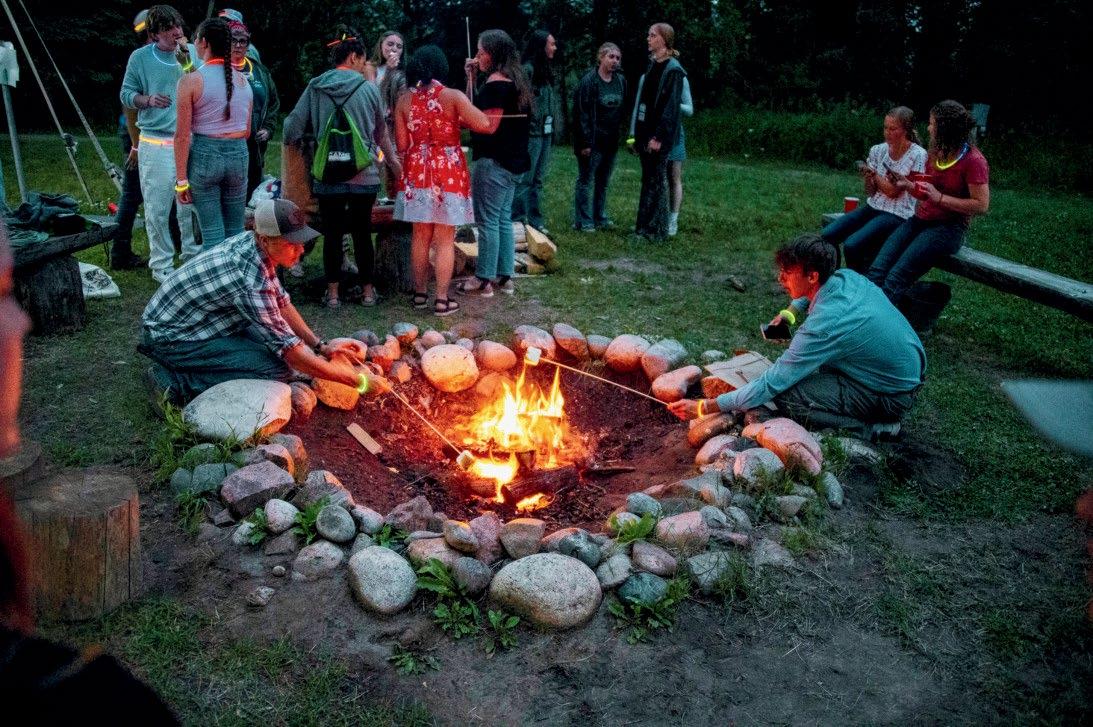




Clean Energy Innovations
Local perspectives on nuclear power safety
During the 2025 Colorado legislative session, House Bill 25-1040: Adding Nuclear Energy as a Clean Energy Resource was passed and signed into law. The bipartisan law officially designates power generated by advanced nuclear reactors as clean energy under Colorado law, and it protects local communities from losing tax revenue if nuclear replaces coal in future projects.
Although this law doesn’t mean nuclear plants are breaking ground tomorrow, it has opened the door for nuclear energy to be part of Colorado’s clean energy future. As a follow-up to our Energy Gap series, we spoke with two local experts — both members of San Isabel Electric — about the safety of modern nuclear power.
NAVY STANDARDS FOR CIVILIAN LIFE
John Pickerill, a former SIEA board director and current member from Pueblo West, served as a nuclear submarine officer in the United States Navy for nearly a decade. He holds a degree in physics from Purdue University.
“In the Navy, safety was our top priority. We had to memorize every system and emergency procedure and were constantly tested on them,” Pickerill said of nuclear submarine equipment. “It took about a year of hands-on training to qualify, and if you missed even one safety question on the final test, you had to start over.” Pickerill said that the crew would spend a quarter of their time running drills to stay prepared for yearly safety inspections.
That type of rigorous safety culture carries over into the civilian nuclear workforce because many commercial nuclear reactor operators are Navy-trained. According to Pickerill, the mindset of constant preparation and zero-tolerance for mistakes is embedded into the industry.
WHAT IT TAKES TO OPERATE A REACTOR
Harold “Hal” Hess, an SIEA member and 11-year Pueblo West resident, spent 43 years testing and maintaining both Navy and civilian nuclear power systems. He has a degree in chemical engineering and was a licensed state mechanical engineer.
“I’ve done safety evaluations in nearly every U.S. nuclear plant and in 13 countries,” Hess said. “In my
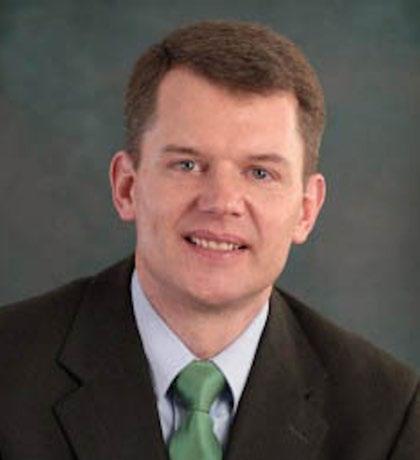
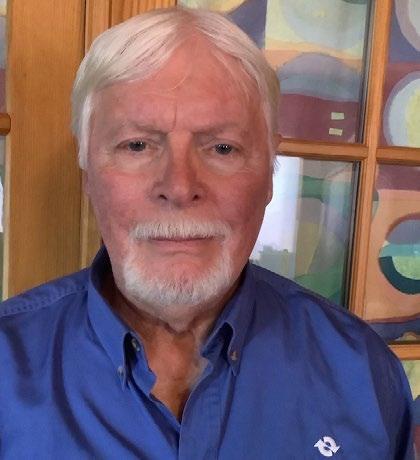
experience, nuclear power is safe, effective, and could be very cost-competitive in the right environment.”
Hess noted that all U.S. nuclear plants underwent extensive upgrades after the high-profile accidents at Three Mile Island, Chernobyl, and Fukushima. These improvements have significantly reduced the chances of similar events happening again. “I’ve studied all three events closely, and the likelihood of anything on that scale happening again — especially in the U.S. — is very low and continues to drop,” he said.
One reason nuclear is safe, both experts agree, is the requirements to entry are strict. Commercial nuclear operators must complete thousands of hours of education and on-the-job training. The plants themselves undergo continuous monitoring, testing, and inspections — with strict regulations set by the U.S. Nuclear Regulatory Commission.
“It’s not just about running the plant day to day,” Pickerill said. “You’re always preparing for every possible emergency — even ones that have never happened. That mindset makes a difference.”
ON THE HORIZON
Two types of advanced nuclear reactors — pressurized water and boiling water — are currently licensed in the U.S. Both have been built before, and the resources and expertise needed to begin construction are already in place. Both types could be started today and completed within four to seven years of signing a contract. They would generate about as much electricity as the Comanche 3 power plant in Pueblo.
Looking ahead, Pickerill is optimistic about a newer design: molten-salt thorium reactors. “Moltensalt thorium reactors can make electricity cheaper than wind or solar,” he said. “Thorium is easy to
John Pickerill
Harold “Hal” Hess
find and the reactor doesn’t need high pressure or a big safety building. It also runs hotter, so it can use a smaller, more efficient turbine to make the same amount of power.” Thorium is a naturally occurring metal found in soil and rock, and it can be used as fuel in certain types of nuclear reactors. It produces less long-term waste and is not feasible for use in nuclear weapons. Pickerill added that the small amount of byproduct these reactors create has useful applications in medicine and space exploration.
FOCUS ON THE FUTURE
As San Isabel Electric objectively explores the challenges and opportunities of a changing energy landscape, we’ll continue sharing local perspectives on national conversations.
WHAT IS THORIUM?
Thorium is a soft, silvery metal found naturally in soil and rock. It is mildly radioactive and much more common than uranium. In certain types of advanced nuclear reactors, thorium can be used as fuel to produce electricity. It creates less long-lasting radioactive waste, and the small amount of byproduct can be used in medical imaging and space probes.

Dig Smart. Dig Safe. It’s the Law.
August 11 is Safe Digging Day

Before you grab a shovel, grab your phone and call 811 or go online to colorado811.org. Even small digging jobs can have big consequences. If you hit a utility line, you could cause a major outage, face serious injury, or be fined. Calling before you dig is fast, free — and it’s the law.
WHAT COUNTS AS DIGGING?
Colorado law defines “excavation” or digging as any operation that moves earth. Some examples include putting in a fence post, planting a tree, digging a trench for irrigation, boring, plowing, tunneling, grading, scraping, hydro-excavating, and more.
STEPS TO A SAFE PROJECT
Step 1: Request a Free Locate
• Call 811 or go online to colorado811.org
• Describe where you’re digging on the locate ticket
• You’ll get a ticket number via email
• Premarking the excavation area in white is recommended
Step 2: Wait for Locates
• Utility locators have three business days to respond
• SIEA’s contractor is Colorado Line Locators
• Wait for color-coded flags or ground markings around your property
Step 3: Wait for a Positive Response
• Required by Colorado law
• Confirms all utilities have responded
• Check status at colorado811.org
Step 4: Dig Safely
• Stay at least 18 inches from markings
• Use hand tools if digging closer to the markings
• Locates expire in 30 days or if marks wash away
You may be held responsible for damage and the costs to repair if you fail to follow these steps.
I DUG INTO A LINE. NOW
WHAT?
• Stop immediately and evacuate if needed
• Never try to fix the damage yourself
• Call SIEA and 811 to report it
Small nicks in underground wires can lead to bigger dangers and outages far from the dig site. Damage must be professionally assessed and repaired.
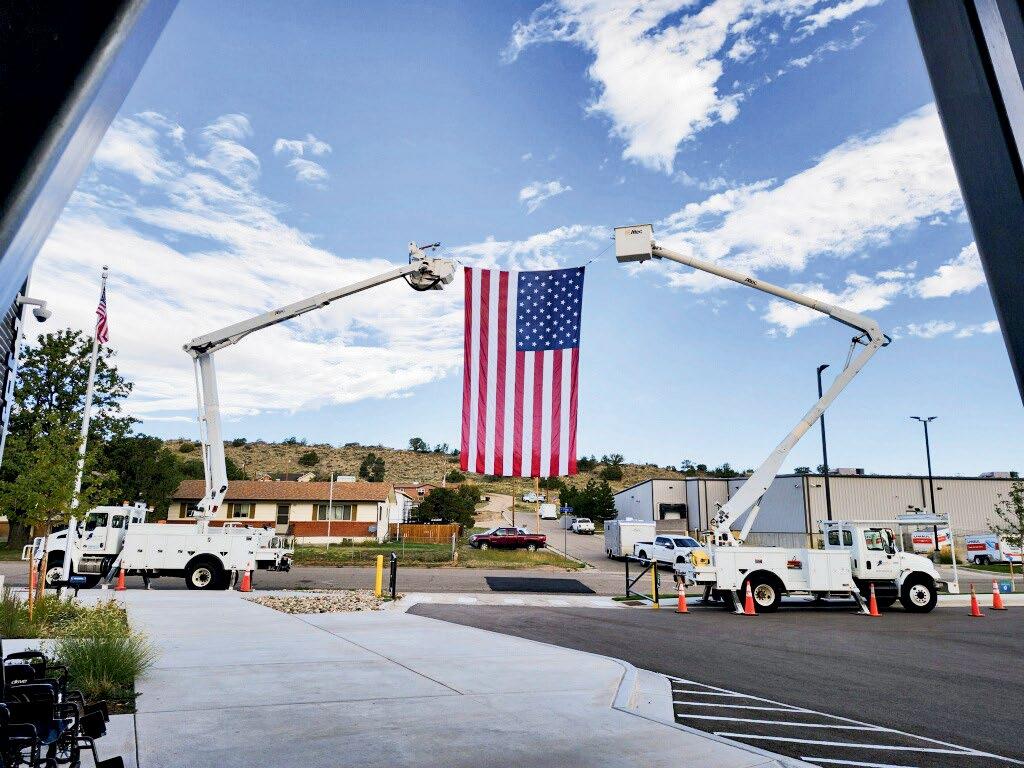
Walsenburg Jr. Sr. High School September 20th
2025 ANNUAL MEETING

Win a 65" flatscreen, free year of electricity, and prizes
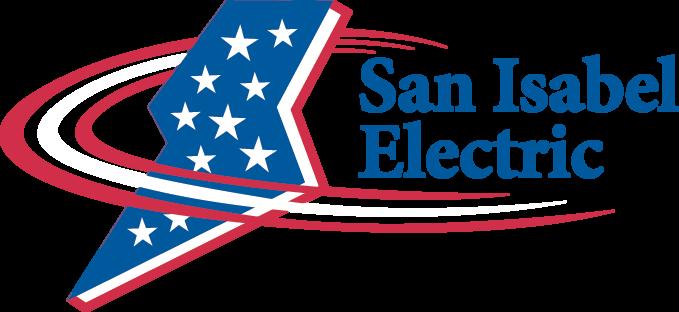
NOTICE OF DIRECTOR NOMINATIONS
The SIEA Nominating Committee met at the Pueblo West office on June 26 to nominate directors to run for the board. There are two director seats up for election this year. The committee nominated:
Dennis Maroney — District 2 –Rye, Colorado City and Vicinity
Doris Morgan — District 8 –Pueblo West Proper
San Isabel Electric operates under seven cooperative principles which includes practicing a Concern for Community. Each board member lives in the community they serve, and we all work together to help our communities thrive.
Each month, the Board of Directors donates to community projects to help keep our communities strong and growing. All philanthropic

Our Energy Transition
By Jon Beyer Chief Executive Officer
Iam honored to be the new Chief Executive Officer at Sangre de Cristo Electric Association. I have worked for electric cooperatives for more than 29 years in various roles, both at the power supply level and the distribution cooperative level. I am joining SDCEA at an important time in the utility industry. The saying “We live in interesting times” certainly applies to the energy industry as we embark on a monumental energy transition in this country.
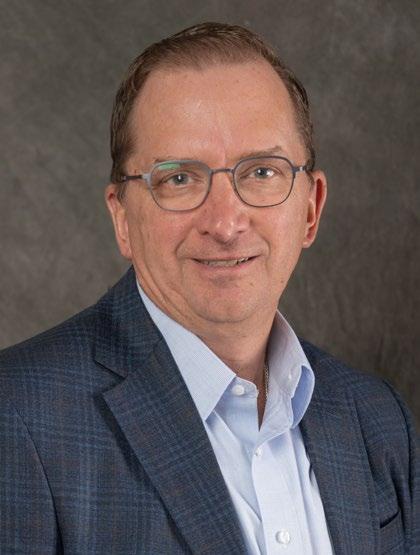
The shift away from central-station baseload power plants that were built decades ago and are typically fueled by coal is a major challenge facing our industry. Many of these power plants are reaching the expected retirement age or need expensive upgrades to extend their lives and utilities are not willing to make these changes for a variety of reasons. In some cases, these retirements occur for environmental benefits.
The question becomes: How do we affordably replace thousands of megawatts of baseload generation while maintaining the grid’s reliability? We are seeing coal plant retirements starting, and large investments in wind and solar energy increasing.
Tri-State Generation and Transmission Association, SDCEA’s wholesale power supplier, is leading the way in this transition. By the end of 2025, Tri-State’s energy portfolio will include more than 2,000 megawatts of clean renewable energy. Half of the energy purchased by SDCEA and supplied to you, our member-owners, will be supplied by renewable resources by the end of 2025. These investments will allow Tri-State and its membership to reduce greenhouse gas emissions by 80% from 2005 levels by 2030.
Why is this transition important to SDCEA? The largest portion of SDCEA’s annual expenses is its wholesale power bill from Tri-State, and a large portion of a member-owner’s bill at SDCEA is related to power cost. Therefore, how the costs of this transition are managed will impact SDCEA and our member-owners for decades to come.
To date, Tri-State has done a good job managing the costs of this transition. However, 2025 is an important milestone in Tri-State’s energy transition as the retirement of its largest baseload resource located in Craig, Colorado, begins. As this multi-year retirement begins, Tri-State is planning for its next baseload resource.
As Tri-State plans its new baseload resource and continues to expand transmission facilities to serve its member cooperatives, the costs to build these assets are increasing and upward rate pressure will follow.
For us at SDCEA, keeping electric bills reasonable is a top priority, as we stand for you, our member. Every day, we focus on managing energy delivery costs to ensure affordability. We have a seat on the Tri-State Board of Directors where we represent your interests directly to the wholesale power supplier. This ensures your voice is heard and prioritized as SDCEA’s power supply evolves. We are committed to advocating for your needs and for keeping cost management at the heart of providing ser vice to you.
As these discussions about the energy transition continue and we learn more about our future power costs, we are committed to keeping you, our members, informed.
P.O. Box 2013
Buena Vista, CO 81211-20131
ph 719-395-2412
tf 844-395-2412
info@myelectric.coop www.myelectric.coop
facebook.com/SDCEA.Inc @sdceaenergy
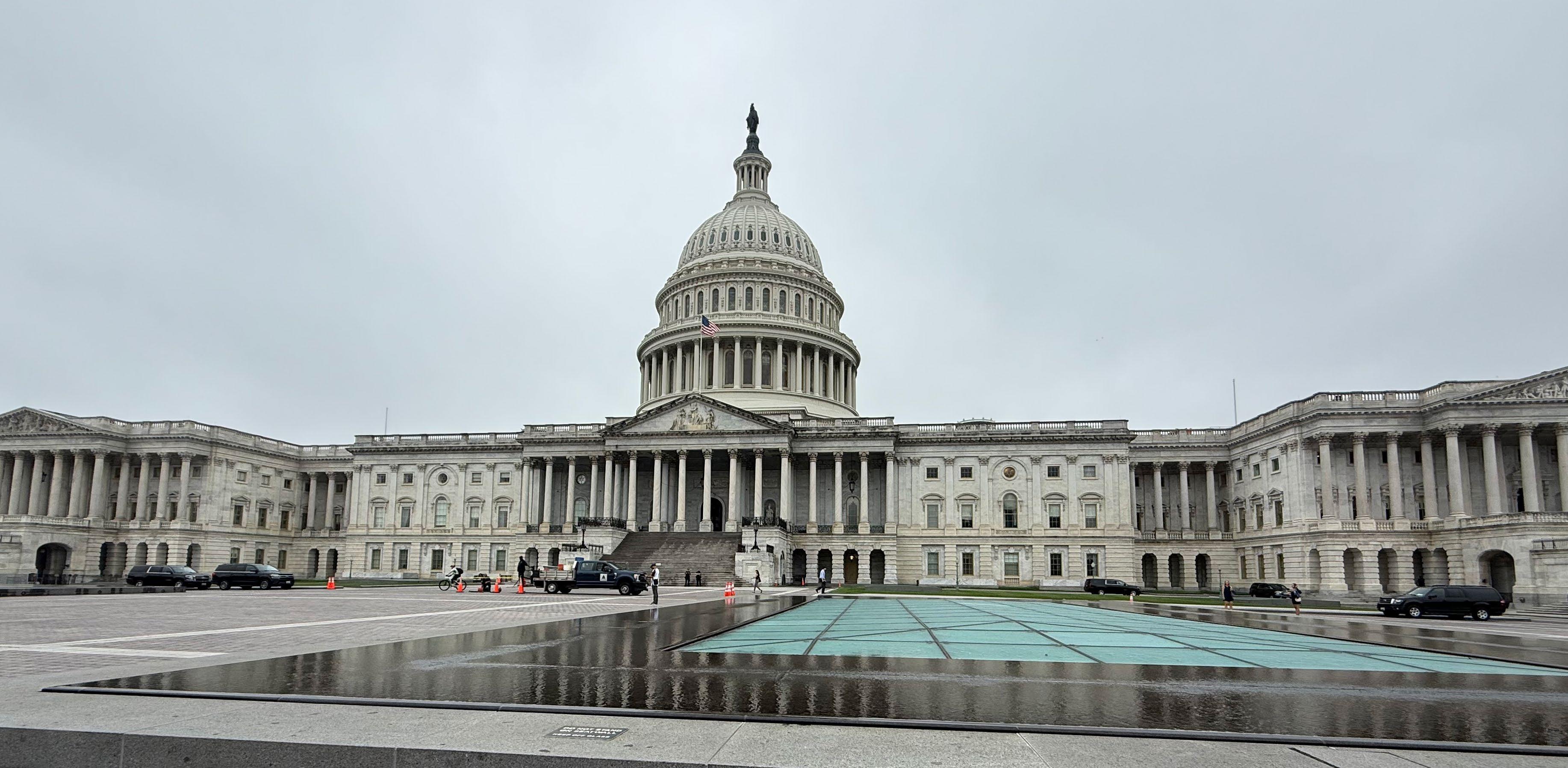
Youth Tour Recap
Fifty-five high school students from Colorado and Wyoming, all sponsored by their local electric cooperative, embarked on an unforgettable trip to Washington, D.C., in June. Among them were four students from SDCEA’s service area — Jenna Shepherd, Aberlyn Leon, Tayler Propernick, and Jamie Nall.
We were thrilled to see these future leaders immerse themselves in our nation’s rich history and governance firsthand. The week was filled with incredible experiences, including visits to national monuments, the Holocaust Memorial Museum, and even a Rockies vs. Nationals baseball game.
Interested in joining next year’s Youth Tour? Applications open this fall! For updates, visit our website at myelectric.coop
GET YOUR DAILY DOSE OF
Caffeine

7:30
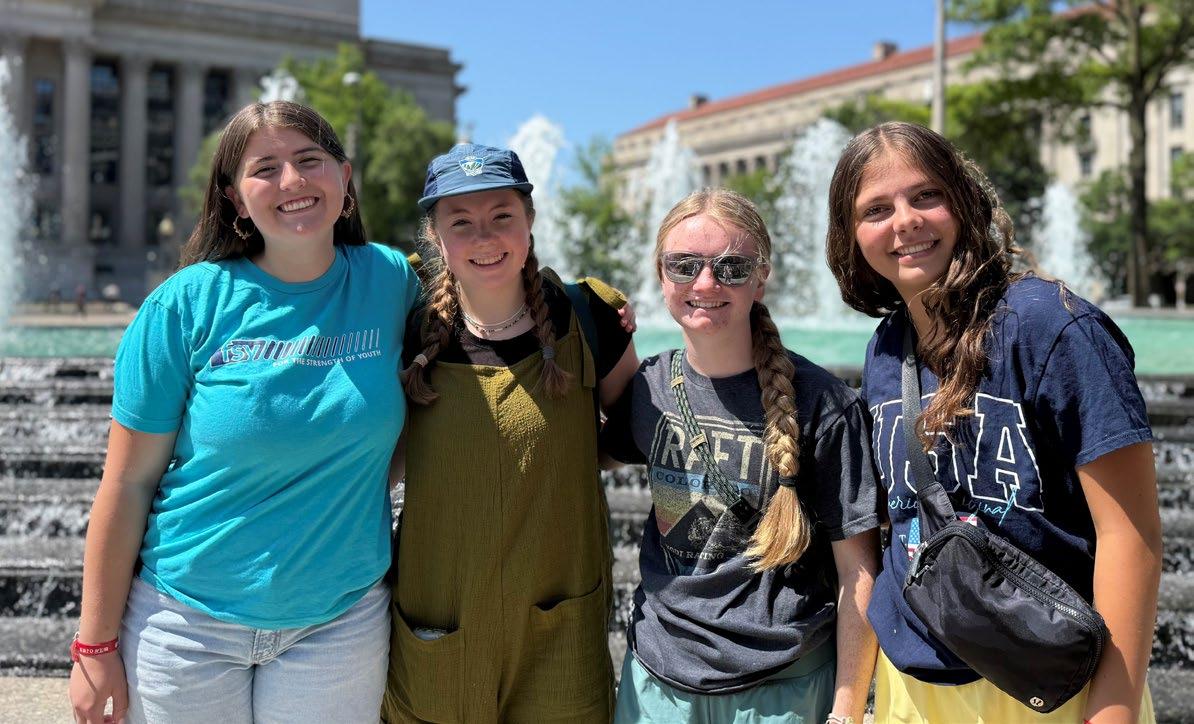
COFFEE WITH THE CO-OP RETURNS IN AUGUST!
Members (account holders at SDCEA) are welcome to join SDCEA employees for free coffee, conversation, and baked goods at the co-op from 7:30 a.m. – 9 a.m. on August 13. Drop by to get your morning pick-me-up and head out on your way to work or take a break and drop in while you’re running early morning errands.
The event will also be a great chance to meet and talk with Jon Beyer, SDCEA’s new CEO. Coffee with the Co-op will be held in the SDCEA community room, 29780 US Hwy 24 N, Buena Vista. For more information, email info@myelectric.coop or call 844-395-2412.
Come to visit, bring any questions you may have about your co-op or your energy supply. We hope to see you there!
Left to right: SDCEA’s Jenna Shepherd, Aberlyn Leon, Jamie Nall, and Tayler Propernick gather at the Navy Memorial in Washington, D.C.
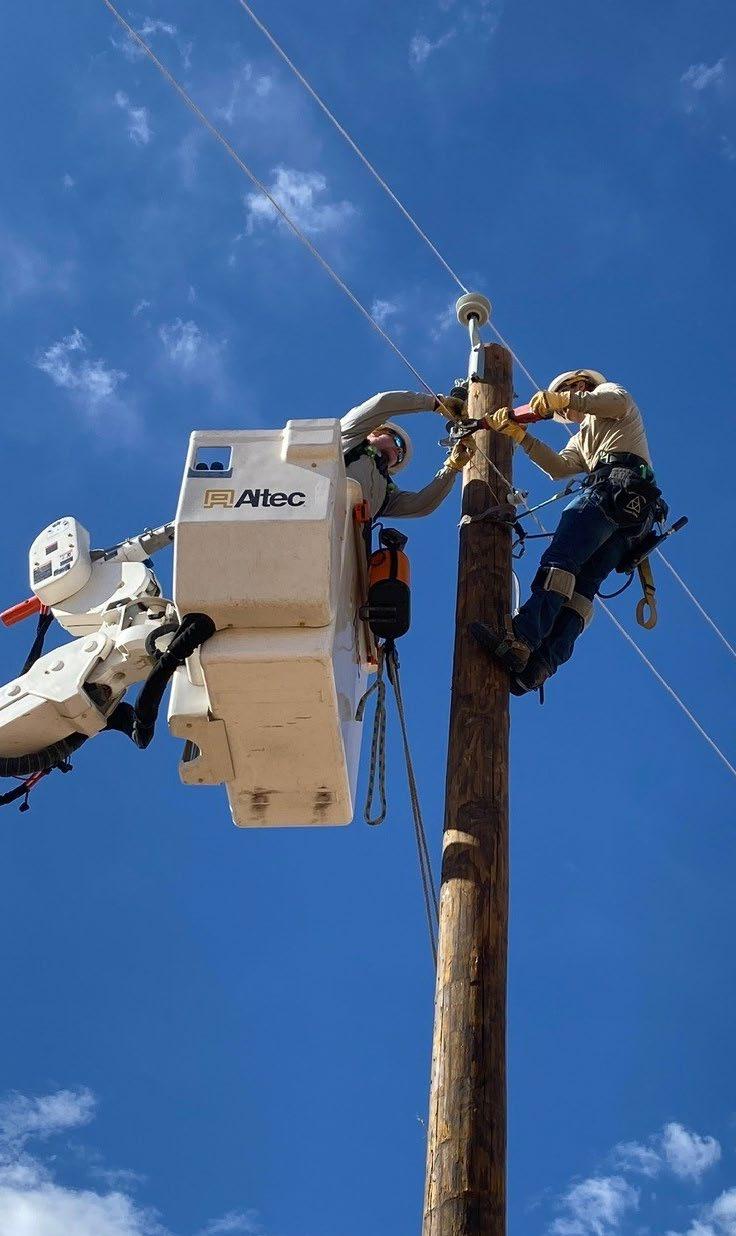
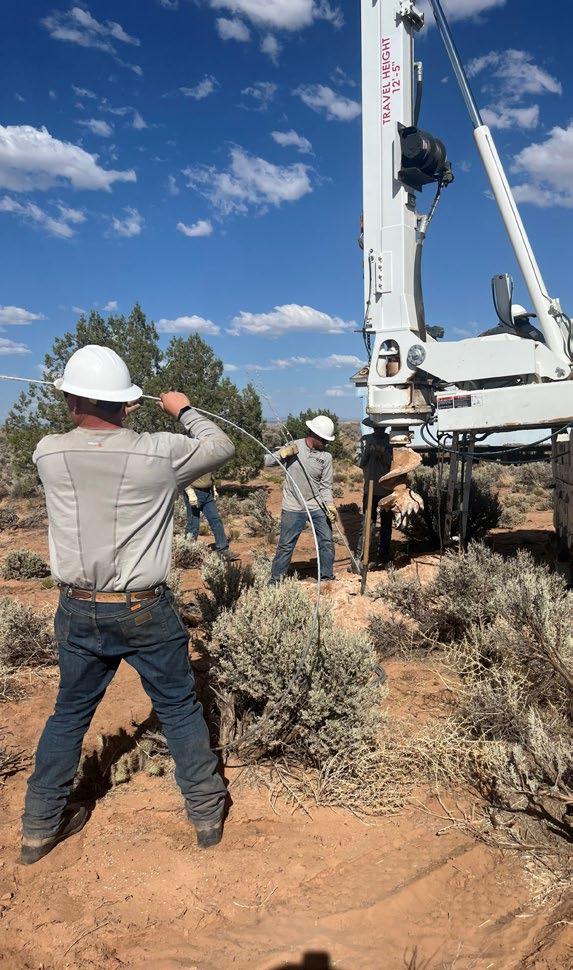
SDCEA Lights Up Navajo Nation
In June, a dedicated crew from SDCEA worked in the Four Corners region to bring electricity to Navajo Nation families in the Shiprock and Red Mesa areas. Teaming up with a crew from Holy Cross Energy, they extended power to six households, transforming lives in ways many of us take for granted.
For these families, this progress means so much more than flipping a switch. It is having the ability to refrigerate fresh food, light up homes after dark, stay cool during scorching summer days, and create a safe, comfortable living environment. These essential services are not just conveniences — they are life changing.
Linemen Evan Wright, Ty Coleman, Lucas Montgomery, Sean Weston, and Matt Overmyer made the trip. This is the second year SDCEA crews have assisted with this initiative in partnership with the Navajo Tribal Utility Authority.
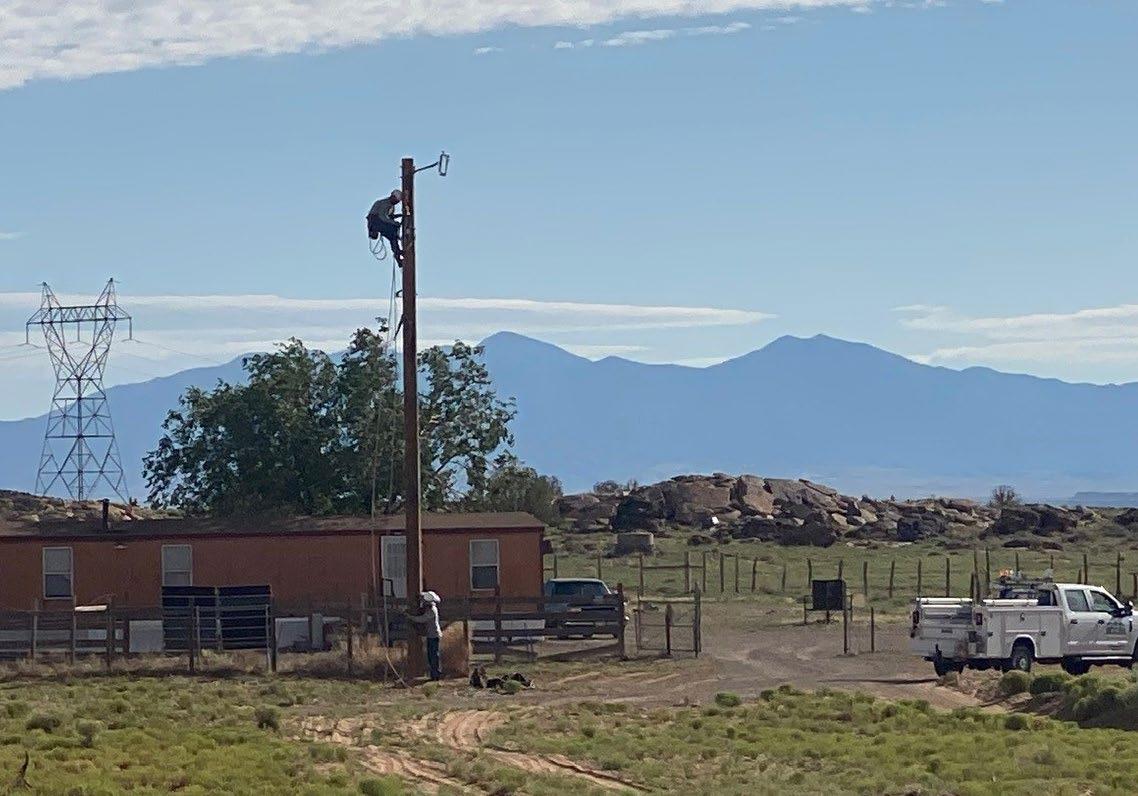
SDCEA BUENA VISTA OFFICE HOURS
Monday–Thursday 8 a.m. – 4:30 p.m.
Dispatch for outages is available 24/7/365 at 844-395-2412.

SDCEA linemen finish adding line to a new power pole.
Crews drill through rock using a pressure digger.
An SDCEA lineman preps a pole for placement of a transformer to provide power to a residence.
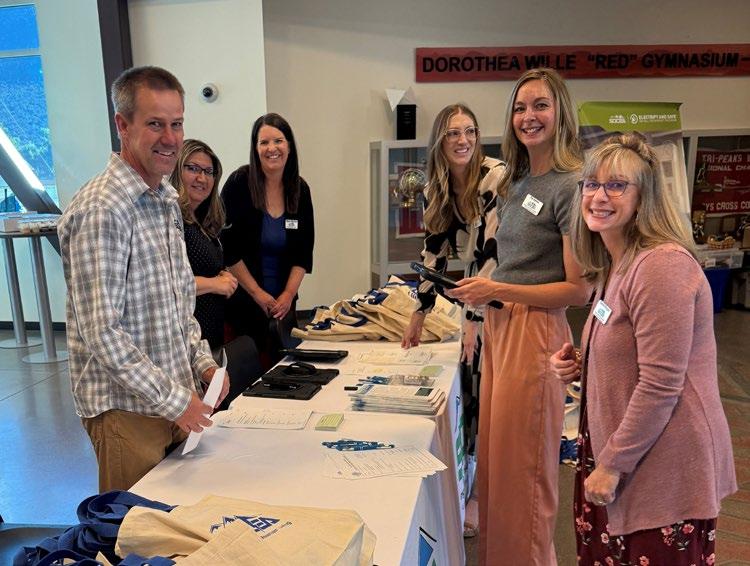
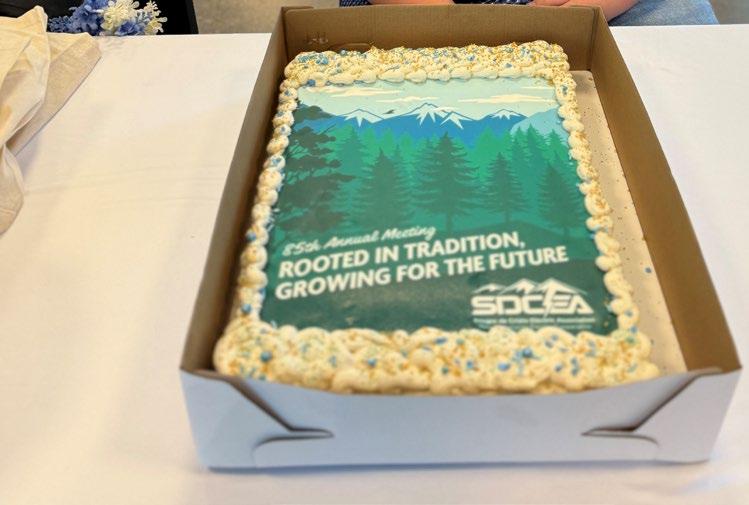
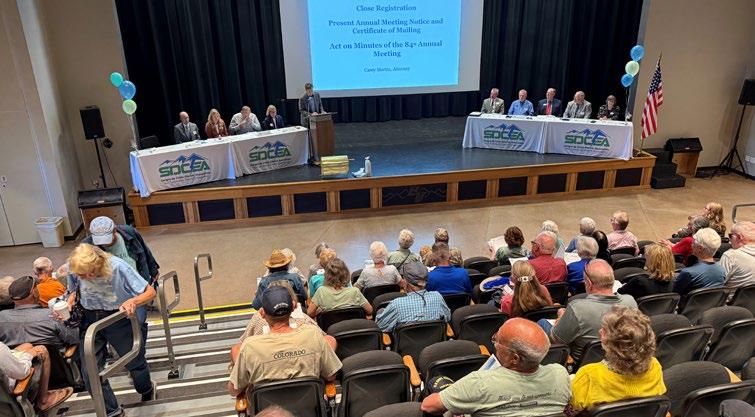
SDCEA Annual Meeting Recap
It was wonderful to connect with both familiar and new faces as we came together to celebrate community, cooperation, and progress at the SDCEA Annual Meeting. Your questions, engagement, and presence truly made this event special.
Held June 19 at Buena Vista High School, this year’s meeting embraced the theme Rooted in Tradition, Growing for the Future. Attendees enjoyed a presentation highlighting the rich history of our cooperative, reminding us of how far we’ve come, and the exciting opportunities that lie ahead.
A special thanks to our featured speaker, Lisa Tiffin, senior vice president of energy management from Tri-State Generation and Transmission, SDCEA’s wholesale power supplier. Her insights on energy management and the future of our cooperative were both informative and thought-provoking.
The meeting was also a time to bid a fond farewell to our retiring CEO Gary Kelly, while warmly welcoming Jon Beyer, who officially stepped into the CEO role on July 7. Beyer’s leadership promises an exciting chapter ahead for SDCEA.
As always, this gathering reminds us of the strength of our community. Serving residents across Chaffee, Fremont, Custer, Lake, and parts of Saguache County; we are grateful for your continued support and collaboration. We can’t wait to see you at next year’s meeting!
CONGRATULATIONS TO SDCEA’S AWARD-WINNING TEAM MEMBERS
Two talented SDCEA staff members have received statewide recognition and received awards in the Colorado Country Life Excellence in Communication contest.
Working Foreman Matt Shepherd was honored for his beautiful photo capturing linemen restoring power during a snowstorm in May 2024. The storm, which parked over our service territory for several days, brought feet of wet, heavy, snow and widespread outages. The award-winning image highlights the dedication and hard work of our line crews, who work around the clock in challenging conditions to restore power to our communities.
Communications Manager Chris McGinnis received an award for her Vegetation Management Alert story. Her article informed members about SDCEA’s wildfire mitigation efforts, highlighting the cooperative’s dedication to safety and environmental stewardship.
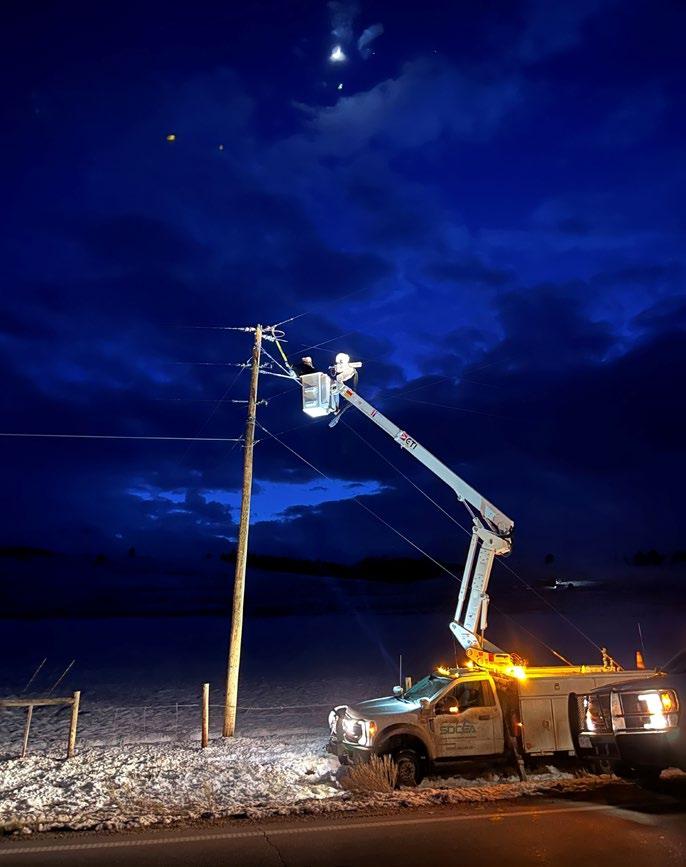
Annual Meeting attendees are greeted by SDCEA’s registration staff.
Sweet Life Bakery in Buena Vista creates this stunning and delicious cake for the event.
Attendees hear presentations at the Annual Meeting.
Matt Shepherd’s award-winning photo, “Goodnight Linemen.”


Who Owns What?
Understanding electric equipment responsibilities
By Kevin Brandon Chief Executive Officer
As summer continues with long days and rising temperatures, it also brings the increased potential for severe weather. Summer storms can arrive quickly and hit hard, sometimes causing significant damage to essential electric equipment throughout our community.
Southeast Colorado Power Association (SECPA) is always prepared to respond swiftly to outages and restore power safely, but it is also important for homeowners to understand which parts of the electric system are their responsibility and which are maintained by us at the co-op. Understanding these key differences can help speed up repairs and ensure everyone stays safe when the weather turns rough.
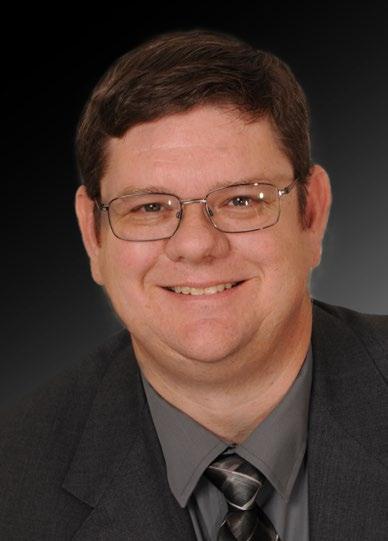
SECPA is responsible for maintaining and repairing the equipment and lines that run to your home, including utility poles, distribution power lines, electric meters and pad-mounted transformers.
SECPA members are responsible for the equipment located between the electric meter and your home or business, including any underground service lines that lead into the structure and the service panel. Members are also responsible for the weatherhead and service mast located outside the home.
If any equipment that you (the homeowner) are responsible for is damaged, please call a licensed elec-
trician to conduct the repairs. A professional has the experience and know-how to assess and manage these types of repairs.
When severe weather damages electrical equipment, it's important to note that any necessary repairs to the homeowner’s equipment must be conducted before SECPA crews can restore power to your home or business. By understanding the equipment you are responsible for, the repair and restoration process will be smoother and faster.
Our community takes great pride in the beautiful trees and landscaping that contribute to the natural beauty where we live, however, regular trimming is essential to ensure reliable electric service and minimize damage from severe weather. SECPA regularly trims trees throughout our service territory to improve service reliability. If you spot a tree limb that is contacting or obstructing a distribution power line outside your home, please call SECPA so we can trim those limbs and maintain those lines.
Any overgrown limbs or vegetation around the service line going to the house is the homeowner’s responsibility, and in these cases, please call a professional tree trimming service to assist.
By working together to understand the essential equipment that powers daily life, we can all be better prepared to start the repair and restoration process if severe weather impacts our community.
27850 Harris Road
P.O. BOX 521
La Junta, CO 81050
Phone: 719-384-2551
Toll Free: 800-332-8634
Fax: 719-384-7320
www.secpa.com
facebook.com/secpaonline
@southeastcoloradopower
Who Owns What?
Electric Co-op Owned Equipment vs Member-Owned Equipment
This graphic depicts equipment owned by the co-op (in gold) and the member (in blue). If a storm damages any equipment owned by the co-op, we are responsible for repairs. If a storm damages any member-owned equipment, the member is responsible for repairs. Members should hire a licensed electrician when making any repairs to member-owned equipment.
Youth Tour Winners Reflect on Trip
AN UNFORGETTABLE WEEK
By Layton Homm
2025 SECPA Youth Tour Delegate
Youth Tour 2025 brought together 50 students from Colorado, and thousands more from across the United States for a once-in-a-lifetime experience in Washington, D.C. It was organized by our local electric co-op, Southeast Colorado Power Association (SECPA).
My mom was chosen as a Youth Tour delegate when she was my age, and in June, I discovered Youth Tour was more than just a trip. It was a chance to learn, grow, and connect. I met people from all kinds of backgrounds, saw places I had only read about in textbooks, and heard directly from people who are helping to lead our country.
During the week, we visited countless museums, memorials, and sites around Washington, D.C.
Experiencing the rotunda and all the statues firsthand during our tour of the United States Capitol made history feel more real. We met with representatives from our districts, and I had a great conversation with McKenna Hamilton, Director of Operations for Representative Lauren Boebert. Hearing how representatives deal with issues at different levels of government was eye-opening.
One of the most meaningful days of the trip was when we visited the war memorials. We started at the World War II Memorial and took pictures with our state pillar. Then we visited the Korean and Vietnam War Memorials. Every delegate was given the name of a fallen soldier from our hometown. We got to find their name on the wall and reflect on their sacrifice. It felt incredibly personal.
The Holocaust Memorial Museum was one of the last tours of the trip. There’s an exhibit where you can scan a photo with an iPad and learn the story of the people in it. It’s heartbreaking. The room filled with shoes left behind by those who never came out of the gas chambers will stay with me.
If you live in the SECPA service territory, apply for this trip. You will come home with a fresh perspective, a ton of new friends, and memories that’ll stay with you for life. I'm incredibly thankful to Southeast Colorado Power for giving me and so many others the opportunity to grow, learn, and explore our nation’s capital.
AN EXPERIENCE OF A LIFETIME
By Larkin Anderson 2025 SECPA Youth Tour Delegate
In June, I was given a once-in-a-lifetime opportunity to experience our nation’s capital, thanks to Southeast Colorado Power Association. I cannot be more grateful for the opportunity that I was given. I followed in my sister's footsteps, who was also selected to be a Youth Tour delegate a few years ago.

The weeklong adventure was full of many well-planned and impactful activities. We toured the Colorado State Capitol where the group of 60 students – all from Colorado’s electric co-ops — got to meet and speak to Senate President James Coleman. When we got to Washington, D.C, we toured Fort McHenry, the United States Capitol, the Washington Monument, and many more sties and memorials
I also experienced the Smithsonian National Museum of Natural History and National Museum of American History. We visited the World War II Memorial, the Vietnam War Memorial, and the U.S. Holocaust Memorial Museum. Experiencing these first-hand was truly an amazing experience.
The trip was so much more than just a chance to see Washington, D.C, it was an opportunity for growth. I was surrounded by amazing leaders who I was able to form meaningful friendships with. I bonded with people not just from my state but from throughout the entire United States thanks to a Potomac Riverboat Cruise and the NRECA Youth Day events.
I am beyond grateful for the chaperones who ensured every event ran smoothly and who also cared about the experience we all received.
Thank you for the experience of a lifetime, Southeast Colorado Power!
Larkin Anderson (right) and Layton Homm visit the Colorado pillar at the World War II Memorial in Washington, D.C., in June. They represented Southeast Colorado Power as delegates on the 2025 Electric Cooperative Youth Tour.
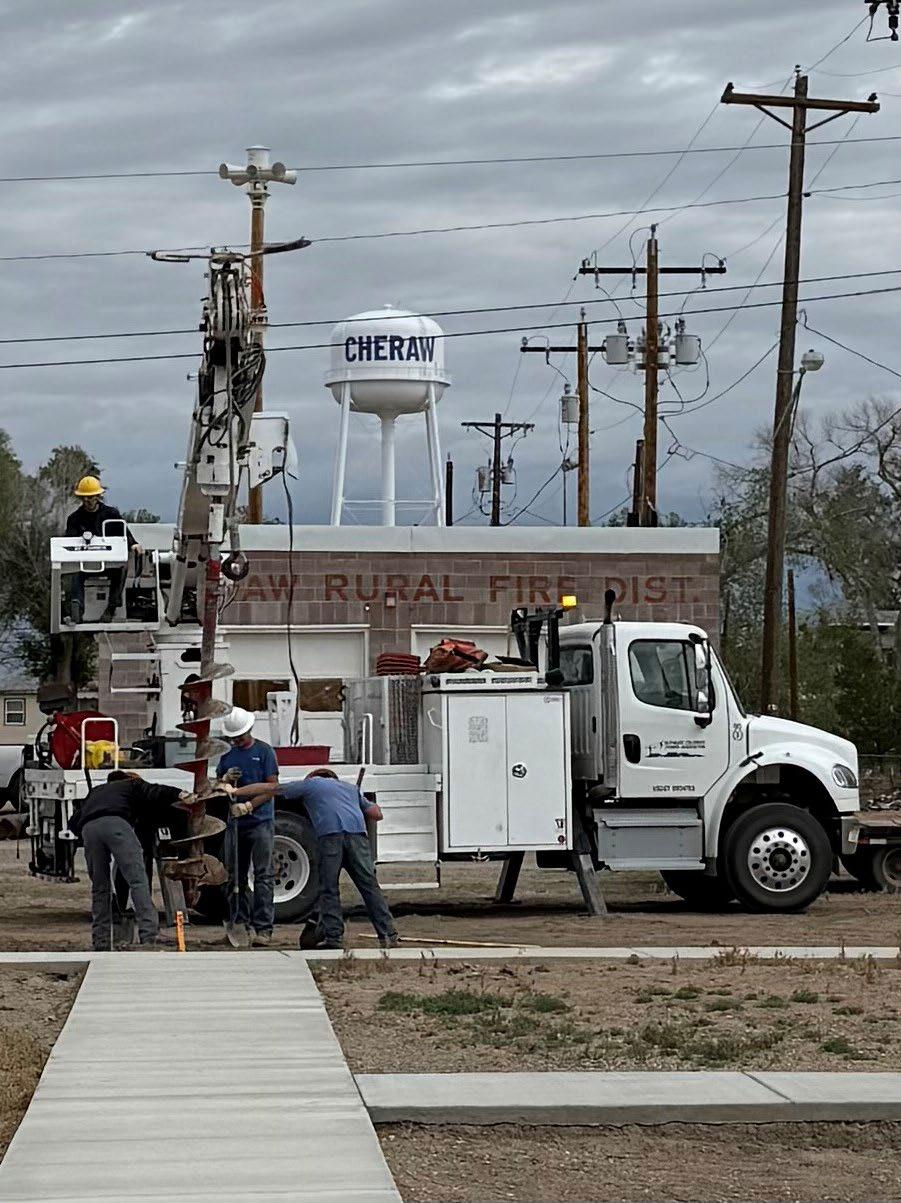
LINECREW WORKS IN CHERAW
Southeast Colorado Power Association’s La Junta linecrew provided trenching services for the new community park and pavilion in Cheraw. Many Cheraw area residents are SECPA members. The community is grateful to be able to enjoy the new park and pavilion thanks to SECPA's work.
FIND YOUR NAME AND WIN!
If you find your name in this issue as follows (WIN* Your Name, your account number), contact Southeast Colorado Power Association at 719-384-2551 or 800-3328634 to receive a $50 credit on your next power bill.




Mutual Aid
The cooperative way
By Trent Loutensock General Manager
Your local electric cooperative, Y-W Electric Association, works hard to reduce the likelihood of power outages by trimming trees, managing vegetation, and maintaining and repairing equipment. But when severe weather strikes, power outages can disrupt daily life in an instant. That’s when a powerful network of cooperation known as mutual aid springs into action — helping communities recover faster.
It’s not unusual to see utility trucks from another Colorado electric cooperative — or even other states — lined up in a parking lot amidst the aftermath of a major storm. These lineworkers leave their families and travel long distances to work in tough conditions to restore power for strangers.
For Y-W Electric staff and members, knowing that help is coming — from near and far — can be a source of comfort during difficult moments.
WHAT IS MUTUAL AID?
Mutual aid is a long-standing system of collaboration in which electric co-ops help one another during major, multiday outages to restore power quickly and safely. David F. Blach 8410xxxxx
Think of it like neighbors helping neighbors, but on a larger scale. If a storm knocks out power in your area and your local crews can’t reach everyone fast enough, other cooperatives may send help in the form of lineworkers and other utility personnel, trucks, and supplies. This support continues until everyone’s power is restored.
HOW IT WORKS
Even with year-round preparation, major weather events can still cause widespread outages. That’s when mutual aid is activated.
Mutual aid agreements are not spontaneous offers of help. They are part of a wellorganized system that allows utilities to quickly request and receive help when disaster strikes. It is most often used after:
• Ice storms or blizzards
• Tornado outbreaks
• Wildfires
• Other large-scale emergencies
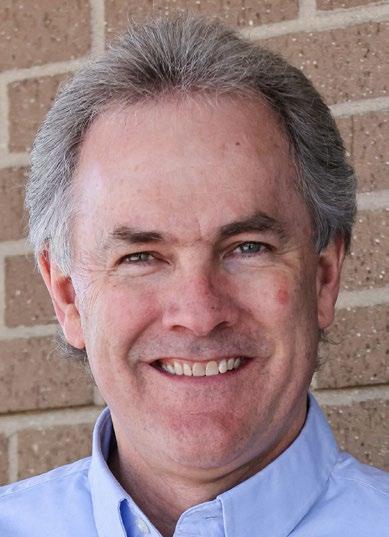
When we at Y-W Electric are expecting a major weather event, we can prearrange support. Crews from neighboring co-ops can be staged nearby and remain ready to respond as soon as conditions are safe. Once deployed, those crews help assess damage, replace poles and lines, and get your lights back on as quickly and safely as possible.
WHY MUTUAL AID MATTERS
Mutual aid dramatically shortens the time it takes to restore power after a disaster. But mutual aid is not just about speed — it’s a powerful example of compassion, resilience, and cooperation. It ensures Y-W Electric members can count on timely service during critical times, and our community can recover more quickly.
Y-W ELECTRIC MISSION
Y-W Electric Association is dedicated to providing high-quality, reliable electric service and related products to our members at competitive prices. Our members deserve and shall receive quality service unexcelled in our industry. We are committed to maintaining an environment where the Board of Directors and employees can perform at maximum potential to benefit our Y-W community.
Mailing Address
P.O. Box Y Akron, CO 80720
Street Address
26862 U.S. Hwy 34 Akron, CO 80720
PH: 970-345-2291
TF: 800-660-2291
ywelectric.coop
CAPITAL CREDITS AND UNCLAIMED CREDITS
Capital credits are a valuable benefit of being a member-owner of Y-W Electric Association. As a not-for-profit organization, Y-W Electric operates at cost and any revenue collected beyond the expenses required to run the cooperative represents the “margins.” These margins are not traditional profits; instead, they belong to YOU, our members, who collectively own the cooperative. Each year these margins are allocated to members as capital credits based on electricity purchased during the year. This allocation reflects your ownership in Y-W Electric.
Over time, Y-W’s board of directors approves the payout of these allocated credits back to the members. To date, Y-W has returned millions of dollars in capital credits to those who have helped build and sustain the cooperative.
If you move out of Y-W’s service territory, please provide a forwarding address to ensure that any capital credits you are owed are returned to you. Many people do not do this, and those capital credits go unclaimed. Visit ywelectric.coop for the most up-to-date list of unclaimed capital credits. To make it easier to locate a name, there is search function and you can search by first name or last name. If your name is on the list, please contact Y-W Electric at 970-345-2291. If you see a relative or friend’s name on the list, please ask them to give us a call.
Y-W Electric makes every effort to find former members who are owed capital credits. However, if these capital credits remain unclaimed for a period of six years or more, the funds are used to support Y-W’s charitable and educational initiatives such as scholarships, Youth Tour, Cooperative Youth Leadership Camp, and various community donations.
If you have any capital credit questions, please give us a call at 970-345-2291 or visit us online at ywelectric.coop.
Welcome Sierra Mireles
TO Y-W ELECTRIC ASSOCIATION
We at Y-W Electric are excited to welcome Sierra Mireles to the team. Sierra began her role as Operations and Engineering Clerk on June 16 and we’re thrilled to have her on board.
A lifelong resident of Akron, Colorado, Sierra is a proud graduate of Akron High School. She earned her Bachelor of Science degree in business administration from Colorado State University. Before joining Y-W Electric, she served as branch manager at Equitable Savings and Loan in Akron, where she built a strong reputation for leadership and community engagement.
Outside of work, Sierra enjoys spending time with her husband, Shea, and their children — Jensen, Lincoln, Mia, and Merritt. In her free time, she loves reading and running.
Please join us in giving Sierra a warm welcome to the Y-W Electric family. Welcome aboard, Sierra!

Protect Yourself During an Outage
Make a plan for your medical equipment and stay safe
We at Y-W Electric Association, Inc. are proud to provide our members with reliable power. In fact, over the last five years, Y-W Electric has had a 95.95% reliability average. This equates to 4.5 hours of annual outage time per meter. But as we all know, severe weather or equipment failures can knock out electricity without warning. If you or a loved one relies on an electronic medical device, a power outage isn’t just an inconvenience — it could be life-threatening. It is essential to have a plan in place to stay safe. If you live with an electric medical device, contact Y-W Electric at 970-345-2291 before an outage happens. We offer an in-house notification program to alert us to a medical necessity associated with an account. While we work hard to restore power as quickly as possible, members may face delays during widespread outages. That’s why it’s so important to be prepared.
PREPARE MEDICAL EQUIPMENT FOR AN OUTAGE
Document your devices.
Keep a file that includes the device’s manufacturer, model, serial number, instruction manuals, and a photo. This information can be useful for repairs, replacement, or communicating with your insurance provider. Joel and Michelle Dracon 2502xxxxx
Know your backup options.
Find out if your device is compatible with backup power like batteries or a generator. Check how long it can operate during an outage. Follow the manufacturer’s recommendations and keep device-specific supplies on hand.
Keep devices maintained.
Make sure equipment is clean, calibrated, and working properly ahead of time. Routine maintenance helps prevent surprises during emergencies.
Charge up.
Keep your cell phone, backup power sources, and battery-powered medical devices fully charged. Keep extra batteries on hand, especially during storm season. Max A. and Joan Olsen 7216xxxxx
Create an evacuation plan.
Have a plan in case you need to leave your home. Identify locations of emergency shelters and power stations in your area. Talk with family or friends about places you can go that have power and are accessible.
Stock up for two weeks.
Keep a two-week supply of medications, medical accessories, and essentials like coolers and refrigeration packs for temperature-sensitive medicine.
Consider manual alternatives.
Look for portable, dependable alternatives to electronic medical devices — for example, a manual wheelchair, walker, or cane as a backup for an electric scooter.
Review your insurance coverage.
Before disaster strikes, talk with your insurance provider so you know what’s covered if your medical device is damaged during a weather event or power outage.
Delete deceptive emails. If you receive an email that appears to be from your electric utility but you are unsure about it, delete it. Never click on a link, open an attachment, or send a reply to an untrusted source. When in doubt, contact your utility directly to report suspected email scams.

Teen Driver Safety
Parenting teens can be challenging. While some battles aren’t worth fighting, protecting your teen behind the wheel of a car is.
And although no one wants to think about teens being in car accidents, it does happen. Protecting your teen behind the wheel is crucial due to their inexperience, which makes them more susceptible to crashes. Car accidents are a leading cause of death for teens in the United States, with the highest risk in the first year of driving. Common hazards include additional passengers, speeding, drowsy driving, and using phones. Jeremy and Crystal Juhnke 10829xxxxx
Typically, more than 3,000 people die each year in crashes involving distracted drivers, including teens. Teen drivers often lack the skills and experience needed to avoid fatal crashes, and distractions such as texting can be particularly dangerous. For example, reading a text at 55 mph is like driving the length of a football field with your eyes closed. For this reason, Colorado has laws against texting, talking on the phone, and engaging in other distractions while driving.
There are three types of driving distractions to discuss with your teen:
• Visual, when you take your eyes off the road.
• Manual, when you take your hands off the wheel.
• Cognitive, when you take your mind off driving.

Teach your teens these tips — remember your example is the best teacher:
• Do not text while driving.
• Set your phone settings to block texts and keep your phone out of sight.
• Avoid eating while driving.
• Use playlists instead of searching for music.
• Set up navigation before driving or have a passenger navigate. Mark Wells 20160xxxxx
Teen drivers report pressure from families and friends to use phones while driving. Many drivers continue to use phones even when they are aware of the crash risk. Technology can help avoid cell phone use while driving. Use built-in features on your smartphone or cell phone blocking apps to prevent distractions. For the greatest safety benefit, change your phone settings to block calls and text messages.
Make sure your teen knows what to do if they encounter downed power lines: Stay in the vehicle, call 911, and stay at least 50 feet away from the scene if they are a witness to an accident.
Downed lines or other damaged utility equipment can look lifeless and harmless yet still be energized. Power lines do not have to be sparking, moving, or sizzling to be energized.
For more safety tips, visit SafeElectricity.org and consider downloading a Parent-Teen Driving Agreement from the Centers for Disease Control and Prevention.
Each month, Y-W Electric Association offers its members a chance to earn a $20 credit on their next electric bill. If you find your name and account number in this magazine, call 800-660-2291 and ask for your credit. It couldn’t be easier. Get acquainted with your account number, read your Colorado Country Life magazine, and pick up the phone. You must claim your credit during the month in which your name appears in the magazine — check the date on the front cover.
Unfortunately, no one listed in the June issue found their name and called to claim their bill credit.
